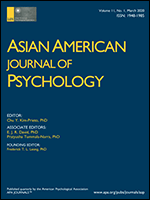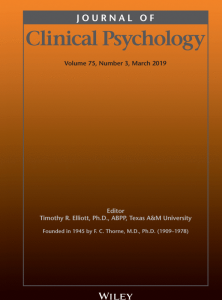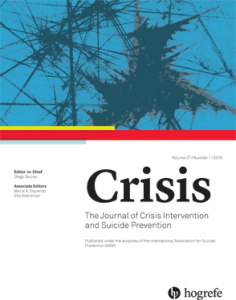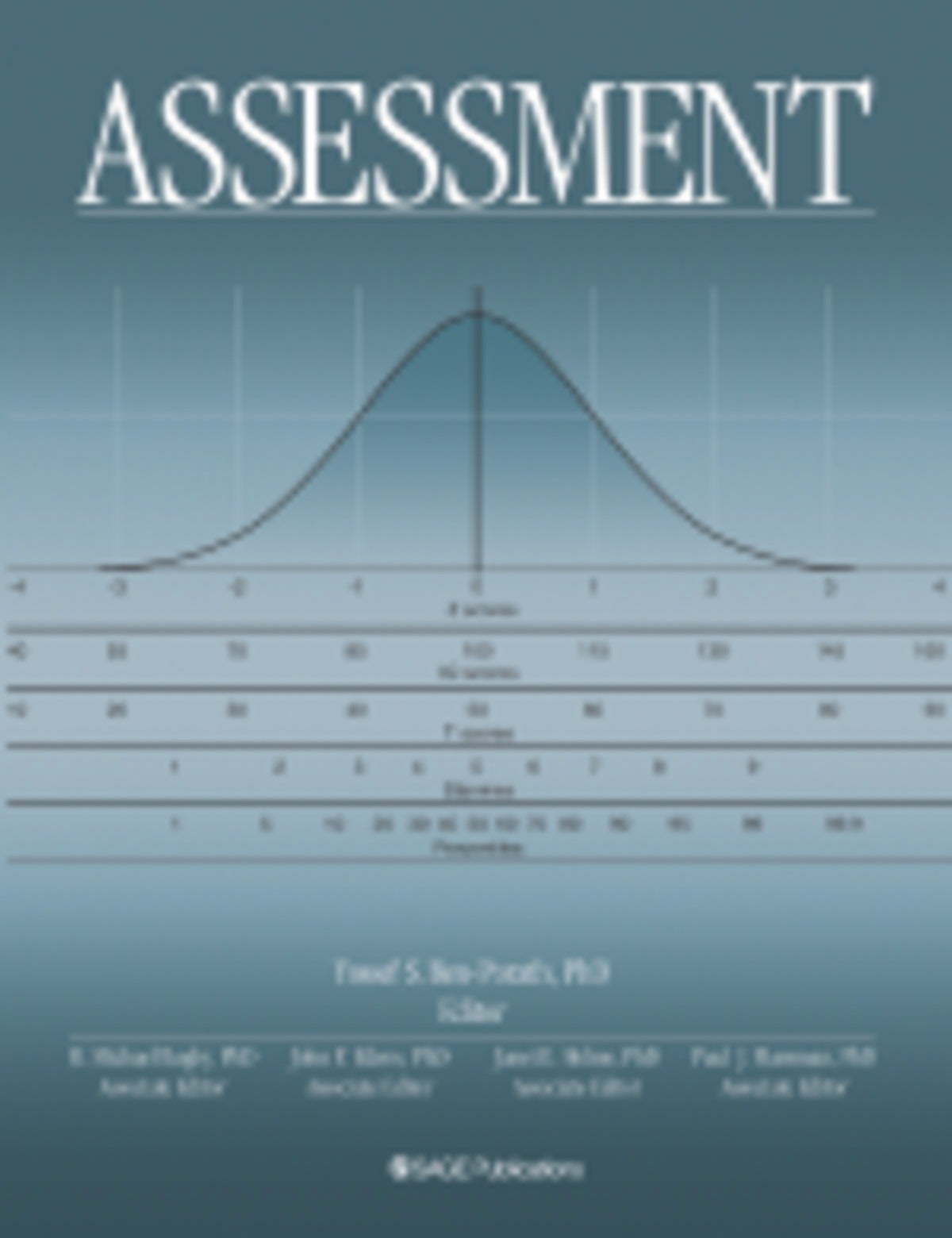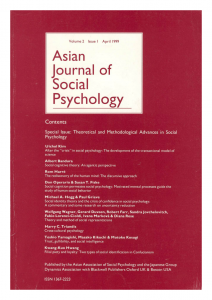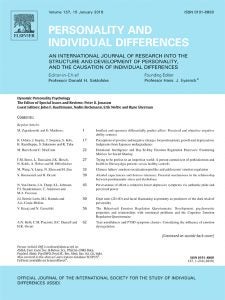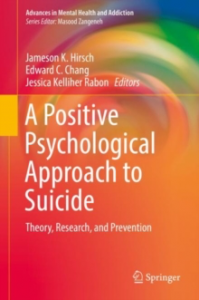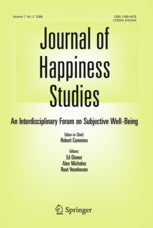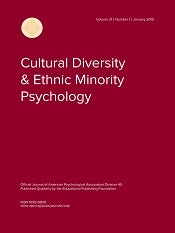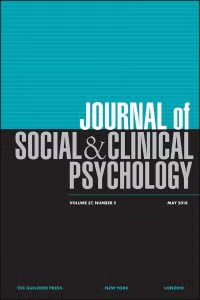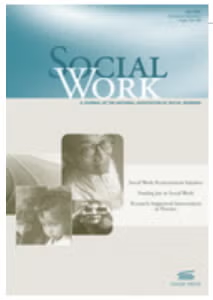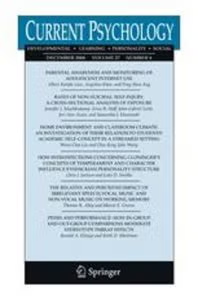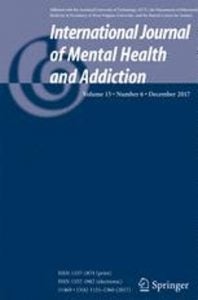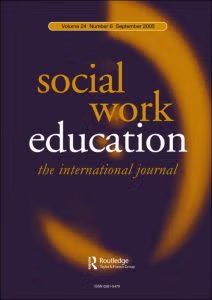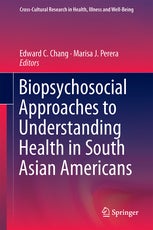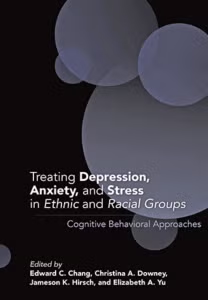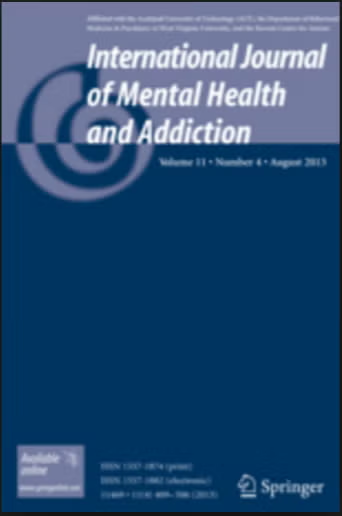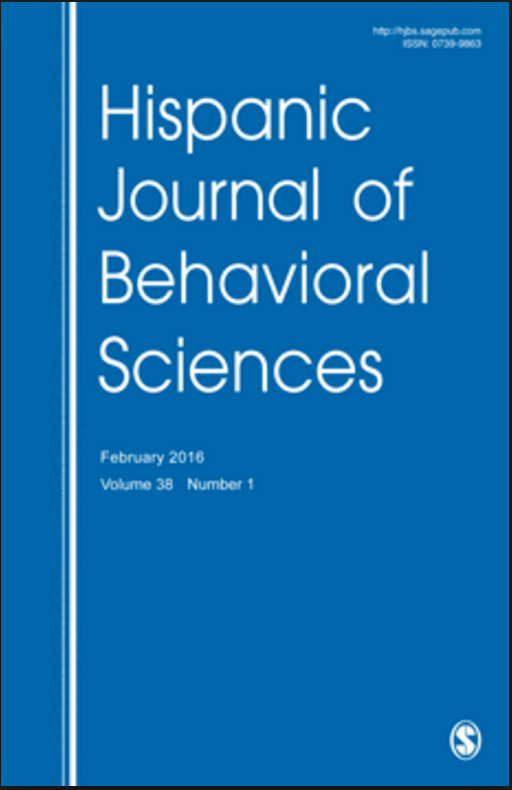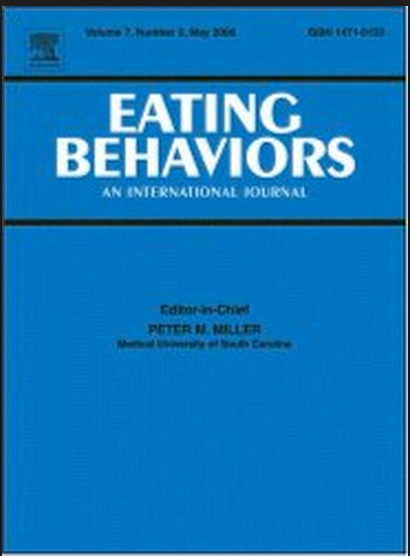VALIDITY OF THE FREQUENCY OF SUICIDAL IDEATION INVENTORY IN BRAZILIAN ADULTS
Maycoln Teodoro, Ronaldo Santhiago Bonfim de Souza, Carolina de Castro Martins, Cristina Yumi Nougueira Sediyama, Juliana Alvares-Teodoro, Olivia D. Chang & Edward C. Chang
Death Studies.
We examined the validity of the Brazilian Frequency of Suicidal Ideation Inventory (FSII-Br), an adaptation of the Frequency of Suicidal Ideation Inventory (FSII), in 946 Brazilian undergraduates. Confirmatory factor analysis of the FSII-Br demonstrated a one-factor model accounting for 62.39% of the variance in FSII-Br scores with a good FIT index. Correlation analyses demonstrated that the FSII-Br was positively correlated with both measures of suicide ideation and suicide risk (viz., depressive symptoms, anxious symptoms, & hopelessness), providing construct validity. Thus, the FSII-Br was found to be a promising tool in assessing suicide risk among Brazilian adults.
RELATIONAL MEANING IN LIFE AS A PREDICTOR OF INTERPERSONAL WELL-BEING: A PROSPECTIVE ANALYSIS
Elizabeth A. Yu & Edward C. Chang
Personality and Individual Differences.
The present study sought to examine personal meaning in life (PMIL) as a predictor of a wide range of interpersonal well-being outcomes (e.g., positive friendship functions, family life satisfaction, positive relationships). Furthermore, relational meaning in life (RMIL) was examined as a predictor of interpersonal well-being outcomes, above and beyond personal meaning in life. The study implemented a prospective. design within a community adult sample. PMIL was found to account for a significant amount of variance in all of the interpersonal well-being outcomes examined for in the present study, and importantly, RMIL accounted for a significant amount of unique variance above and beyond PMIL for the majority of interpersonal well-being outcomes. Findings highlight the importance of considering RMIL, especially when the outcomes are interpersonal.
LONELINESS, SOCIAL PROBLEM SOLVING, AND NEGATIVE AFFECTIVE SYMPTOMS: NEGATIVE PROBLEM ORIENTATION AS A KEY MECHANISM
Edward C. Chang, Jiting Liu, Shangwen Yi, Xinying Jiang, Qiwei Li, Ruoqian Wang, Weiyi Tian, Xinyun Gao, Mingqi Li, Abigael G. Lucas, & Olivia D. Chang
Personality and Individual Differences.
The goal of this study was to determine if social problem-solving processes, as measured by the Social Problem-Solving Inventory-Revised (D’Zurilla, Nezu, & Maydeu-Olivares, 2002), might account for the positive association between loneliness and negative affective symptoms, namely, anxious and depressive symptoms in a sample of 165 college students. Controlling for gender, we tested a multiple mediation model in which social problem-solving processes were hypothesized to account for the loneliness-negative affective symptoms link. Results of these mediation analyses indicated that negative problem orientation fully mediated the positive association found between loneliness and anxious symptoms. Alternatively, negative problem orientation only partially mediated the positive association found between loneliness and depressive symptoms. These findings indicate that beyond loneliness, it would be useful to consider the role of social problem-solving processes, especially negative problem orientation, in predicting negative affective symptoms. Accordingly, our findings point to the usefulness of interventions that not only target reducing loneliness, but also reducing negative problem orientation in adults, in efforts to thwart the development of negative affective symptoms.
DEPRESSIVE SYMPTOMS AND LIFE SATISFACTION IN ASIAN AMERICAN AND EUROPAN AMERICAN COLLEGE STUDENTS: EXAMINING THE ROLES OF SELF-COMPASSION, PERSONAL AND RELATIONAL MEANING IN LIFE
Elizabeth A. Yu & Edward C. Chang
Asian American Journal of Psychology.
This study sought to examine positive psychological constructs as predictors of psychological adjustment and well-being among Asian American college students (N = 188; 125 female, 58 male, 5 “other”). Specifically, the predictive utility of self-compassion, the added predictive utility of personal meaning in life above and beyond self-compassion, and finally, the added predictive utility of relational meaning in life above and beyond self-compassion and personal meaning in life in accounting for variance in depressive symptoms and satisfaction with life was examined. Self-compassion accounted for a significant amount of variance in both depressive symptoms and life satisfaction. Personal meaning in life, accounted for additional unique significant variance, above and beyond self-compassion in both outcomes. Finally, relational meaning in life accounted for additional significant variance above and beyond self-compassion and personal meaning in life in both outcomes. Our findings indicate that self-compassion, personal meaning, and relational meaning are important predictors of depressive symptoms and satisfaction with life among Asian American college students. The findings also provide support for the importance of relationally focused positive psychological constructs, specifically relational meaning in life, in Asian American college student psychological adjustment and well-being.
OPTIMISM AND GRATITUDE ON SUICIDE RISK IN SPANISH ADULTS: EVIDENCE FOR DOUBLING UP OR DOUBLING DOWN?
Nicolás Sánchez-Álvarez, Natalio Extremera, Lourdes Rey, Edward C. Chang, & Olivia D. Chang
Journal of Clinical Psychology.
Objective: The present study examines the role of optimism and gratitude as 3 predictors of suicide risk, namely, depressive symptoms and suicide ideation. Beyond 4 their expected predictive role, optimism and gratitude were also hypothesized to interact 5 together to predict both suicide risk outcomes. 6 Methods: A sample of 1,013 Spanish adults (521 females) participated in this study. 7 The average age was 39.63 years old (SD =16.19, range 16-82). 8 Results: Results indicated that the Optimism × Gratitude interaction term 9 significantly augmented the prediction of both depressive symptoms and suicide 10 ideation. Specifically, pessimists presented with higher risk of suicide, but the effect 11 was weaker among those individuals with higher levels of gratitude. Alternatively, 12 optimists with high gratitude showed the highest amount of protection from suicide risk. 13 Conclusions: Our findings are the first to show how optimism and gratitude might 14 interact as a positive psychological variable to confer greater personal resources in 15 protecting individuals against suicide risk.
FREQUENCY OF SUICIDAL IDEATION INVENTORY: PSYCHOMETRIC PROPERTIES OF THE SPANISH VERSION
Nicolás Sánchez-Álvarez, Lourdes Rey, Natalio Extremera, Edward C. Chang, & Olivia D. Chang
Psicothema.
Background: The Frequency of Suicidal Ideation Inventory (FSII) is a new and brief measure designed to assess for suicide ideation frequency in the last year. To provide evidence of the reliability and validity for the FSII in a Spanish-speaking community, the present study examined the psychometric properties of the Spanish version of the FSII (FSII-S) in a sample of 1,013 adults from southern Spain (51.4% females), ranging from 18 to 82 years old. Method: In addition to the FSII-S, the participants completed the following measures: Suicidal Behaviors Questionnaire-Revised, Beck Depression Inventory, Positive and Negative Affectivity Scale, Flourishing Scale, and Satisfaction with Life Scale. Results: The results of Confirmatory Factor Analysis indicated a good fit for a one-dimensional model of the FSII-S, and high reliability (α = .89). FSII-S scores correlated negatively with suicide protective factors, and positively with suicide risk factors. Multi-group analyses showed the invariance of the factor structure of FSII-S across gender and age. Conclusions: In line with studies in other countries, these findings provide evidence of the validity, reliability, and invariance of the FSII-S as a brief measure of suicidal ideation frequency in Spanish adults.
BEYOND THE ROLE OF LONELINESS IN PSYCHOLOGICAL ILL-BEING AND WELL-BEING IN FEMALES: DO SOCIAL PROBLEM-SOLVING PROCESSES STILL MATTER?
Edward C. Chang, Weiyi Tian, Xinying Jiang, Shangwen Yi, Jiting Liu, Yuetong Bai, Chang Liu, Xuchi Luo, Weijia Wang, Olivia D. Chang, Mingqi Li, & & Jameson K. Hirsch
Personality and Individual Differences.
In the present study, we examined whether social problem-solving processes would add predictive utility over loneliness in accounting for unique variance in ill-being (viz., depressive symptoms & suicide behavior) and well-being (viz., life satisfaction & positive affect) in a sample of 230 females. Results of hierarchical regression analyses indicated that social problem-solving processes added significant predictive utility in accounting for unique variance in depressive symptoms, life satisfaction, and positive affect. Moreover, negative problem orientation emerged as a significant unique predictor of both ill-being and well-being. In contrast, positive problem orientation emerged as a significant unique predictor of well-being and only one index of ill-being. Some implications of the present findings are discussed.
COPING AND SUICIDE IN COLLEGE STUDENTS: DOES BEING OPTIMISTIC MATTER?
Shangwen Yi, Edward C. Chang, Olivia D. Chang, Noelle J. Seward, Leah B. McAvoy, Emmaleigh R. Krause, Miranda R. Schaffer, Claire J. Novak, Ka Ip, & Jameson K. Hirsch
Crisis.
Transitioning to college life in young adulthood can represent a challenging developmental period and college students are at heightened risk for engaging in suicidality. To investigate the roles dispositional optimism and coping strategies play in suicide risk (viz., suicidality) and suicide protection (viz., reasons for living) in college students. A sample of 252 American college students were surveyed using anonymous questionnaires and hierarchical regression analyses were conducted to analyze the data. Coping strategies, as a set, played an important role in both suicidality and reasons for living, after controlling for demographic factors (age & sex). When dispositional optimism was entered into the model, it was found to account for a significant amount of additional unique variance in both suicidality and reasons for living, even after accounting for coping. It is unknown whether optimism remains meaningful in its association with suicide risk and protection beyond coping in other populations. Effective coping and optimism are associated with decreased suicide risk and increased suicide protection. And our findings point to the consistent role of dispositional optimism, over coping, in both suicide risk and protection.
NEGATIVE LIFE EVENTS AND SUICIDE RISK IN COLLEGE STUDENTS: CONDITIONAL INDIRECT EFFECTS OF HOPELESSNESS AND SELF-COMPASSION
Jameson K. Hirsch, Benjamin B. Hall, Haley A. Wise, Byron D. Brooks, Edward C. Chang, and Fuschia M. Sirois
Journal of American College Health.
Suicide risk is a significant public health concern for college students and may be exacerbated by hopelessness resulting from negative life events (NLE), yet may be ameliorated by self-compassion. We examined the mediating role of hopelessness in the relation between NLE and suicidal behavior, and the moderating influence of self-compassion on all model paths. Participants were 338 undergraduates (89% white; 67% female). Data were collected from December 2014 to December 2015. Participants completed the Life Events Checklist for College Students, Beck Hopelessness Inventory, Self-Compassion Scale, and Suicidal Behaviors Questionnaire – Revised. Negative life events were related to greater hopelessness and, in turn, to more suicidal behavior, yet self-compassion attenuated this effect. Self-compassion may buffer the NLE–hopelessness linkage, thereby reducing suicide risk among college students. Therapeutic promotion of self-compassion, and reduction of hopelessness, may be important suicide prevention strategies on college campuses.
MEASUREMENT INVARIANCE OF THE FIVE FACTOR MODEL OF PERSONALITY: FACET-LEVEL ANALYSES AMONG EURO AND ASIAN AMERICANS
P. Priscilla Lui, Douglas B. Samuel, David Rollock, Frederick T. L. Leong, & Edward C. Chang
Assessment.
Relative to broad Big Five domains, personality facets provide incremental value in predicting life outcomes. Valid between-group comparisons of means and correlates of facet scores are contingent upon measurement invariance of personality measures. Research on culture and Big Five personality has been largely limited to cross-national comparisons of domains, without assessing measurement invariance across ethnoracial groups within the same country. Using the NEO Inventories, we tested facet-level measurement invariance between Euro (N = 418, 63.2% women, Mage = 18.43) and Asian Americans (N = 429, 56.6% women, Mage = 18.00). Multigroup exploratory factor analysis within a confirmatory factor analysis framework showed partial strong invariance. Assertiveness and activity did not load onto extraversion as strongly for Asian Americans. Self-consciousness showed a stronger cross-loading onto extraversion among Asian Americans than Euro Americans. Achievement striving, competence, warmth, tender- mindedness, and excitement seeking showed noninvariant intercepts across groups. Collectivistic values emphasizing interpersonal harmony and modesty should be considered when examining narrow and broad traits among Asian Americans.
AN EXAMINATION OF EATING AND THINNESS EXPECTANCIES AS PREDICTORS OF EATING DISTURBANCES IN FEMALES: EVIDENCE FOR CULTURAL DIFFERENCES BETWEEN EUROPEAN AMERICAN AND CHINESE COLLEGE STUDENTS
Mingqi Li, Edward C. Chang, Olivia D. Chang, & Abigael G. Lucas
Eating and Weight Disorders.
Purpose: This study sought to examine for the utility of eating expectancy, thinness expectancy, and the interactive role of both, in predicting eating disturbances (viz., bulimic symptoms & drive for thinness) in European American and Chinese female college students. Methods: A sample of 237 European American and 221 Chinese female college students completed measures of eating and thinness expectancies and eating disturbances. Results: Results of hierarchical regression analyses revealed that thinness expectancy significantly predicted increases in both drive for thinness and bulimic symptoms (with these increases being greater for European Americans), whereas eating expectancy predicted increases in bulimic symptoms only. In addition, for European Americans, a significant interaction for bulimic symptoms was found, revealing a synergistic increase in bulimic symptoms for those with both a high thinness expectancy and a high eating expectancy. For Chinese, a significant interaction for drive for thinness was found, demonstrating that for those with a high thinness expectancy, a higher eating expectancy was actually associated with a lower drive for thinness. Conclusion: The present findings point to the value of examining for the co-presence of both expectancies in predicting eating disturbances while also highlighting cultural variations in the study of eating pathology.
IS PERSONAL GROWTH INITIATIVE ASSOCIATED WITH LATER LIFE SATISFACTION IN CHINESE COLLEGE STUDENTS?: A 15-WEEK PROSPECTIVE ANALYSIS
Edward C. Chang, Hongfei Yang, Shangwen Yi, Fei Xie, Jiting Liu, Haining Ren, Jiaqi Zhang, Zhuoran Zhang, Runzhe Wu, Yijing Lin, Mingqi Li, Kaidi Wu, Ka Ip, Abigael G. Lucas, & Olivia D. Chang
Asian Journal of Social Psychology.
Personal growth initiative is presumed to foster positive change leading to positive psychological adjustment. Accordingly, in this study we examined personal growth initiative as a predictor of life satisfaction 15 weeks later in a sample of 152 Chinese college students. Time 1 personal growth initiative was found to explain a significant amount of unique variance in Time 2 life satisfaction, even after controlling for Time 1 life satisfaction and Time 2 personal growth initiative. Specifically, (lower) intentional behavior and planfulness at baseline emerged as significant predictors of later life satisfaction. No evidence was found indicating that life satisfaction at Time 1 accounted for any significant amount of unique variance in personal growth initiative processes at Time 2, after controlling for baseline personal growth initiative processes and concurrent life satisfaction. Overall, the present findings are the first to demonstrate the importance of personal growth initiative as a prospective predictor of positive psychological adjustment in adults.
SEXUAL ASSAULT HISTORY AND SELF-DESTRUCTIVE BEHAVIORS IN WOMEN COLLEGE STUDENTS: TESTING THE PERNICIOUSNESS OF PERFECTIONISM IN PREDICTING NON-SUICIDAL SELF-INJURY AND SUICIDAL BEHAVIORS
Edward C. Chang, Miranda R. Shaffer, Claire J. Novak, Devin B. Ablow, Alaina E. Gregory, Olivia D. Chang, Abigael G. Lucas, & Jameson K. Hirsch
Personality and Individual Differences.
The present study examined presence of sexual assault history and perfectionism (viz., positive strivings & evaluative concerns) as predictors of self-destructive behaviors (viz., NSSI & suicidal behaviors) in a sample of 287 women college students. Results obtained from conducting a series of hierarchical regression analyses indicated several notable patterns. Sexual assault history was a consistent predictor of both NSSI and suicidal behaviors. Moreover, the inclusion of perfectionism was also found to consistently predict additional unique variance in NSSI and suicidal behaviors, even after accounting for sexual assault history. These patterns remained largely unchanged even after accounting for shared variance between NSSI and suicidal behaviors. Within the perfectionism set, evaluative concerns emerged as the most consistent unique predictor of both indices of self-destructive behavior. Finally, we did not find evidence for a significant Positive Strivings ́ Evaluative Concerns interaction effect in our analyses. Overall, our findings indicate that beyond the presence of sexual assault history, perfectionism remains an important predictor of self-destructive behaviors in women college students.
TRAUMA AND SUICIDE RISK IN COLLEGE STUDENTS: DOES LACK OF AGENCY, LACK OF PATHWAYS, OR BOTH, ADD TO FURTHER RISK?
Abigael G. Lucas, Edward C. Chang, Mingqi Li, Olivia D. Chang, Elizabeth A. Yu, & Jameson K. Hirsch
Social Work.
The present study sought to examine trauma history and hope as predictors of suicide risk in a sample of 561 college students. Furthermore, we aimed to understand if the lack of hope agency and hope pathways contributed to further risk for suicide, above and beyond trauma history. Results suggested that trauma history and hope agency were significant and unique predictors of suicide risk among college students. More specifically, hope agency accounted for additional variance in the prediction model of suicide risk, beyond that accounted for by trauma history. Some implications of the present findings for social work practice are discussed.
A POSITIVE PSYCHOLOGICAL APPROACH TO SUICIDE
Theory, Research, and Prevention
Jameson K. Hirsch, Edward C. Chang, & Jessica Kelliher Rabon (Eds.)
This inspiring resource presents theories, findings, and interventions from Positive Suicidology, an emerging strengths-based approach to suicide prevention. Its synthesis of positive psychology and suicidology theories offers a science-based framework for promoting wellbeing to complement or, if appropriate, replace traditional deficit-driven theories and therapies used in reducing suicidal thoughts and behaviors. Coverage reviews interpersonal, intrapersonal, and societal risk factors for suicide, and identifies protective factors, such as hope and resilience, that can be enhanced in therapy. From there, chapters detail a palette of approaches and applications of Positive Suicidology, from the powerful motivating forces described in Self-Determination Theory to meaning-building physical and social activities.
COPING BEHAVIORS AS PREDICTORS OF HEDONIC WELL-BEING IN ASIAN INDIANS: DOES BEING OPTIMISTIC STILL MAKE A DIFFERENCE?
Edward C. Chang, Shangwen Yi, Jiting Liu, Shanmukh V. Kamble, Yujia Zhang, Bowen Shi, Yangming Ye, Yuan Fang, Kailin Cheng, Jianjie Xu, Jingyi Shen, Mingqi Li, & Olivia D. Chang
Journal of Happiness Studies.
The present study examined optimism, as measured by the Life Orientation Test-Revised, and coping behaviors, as measured by the COPE scale, as predictors of hedonic well-being (viz., life satisfaction, positive affect, & subjective happiness) in a sample of 462 Asian Indians (237 women & 225 men). We hypothesized that optimism would remain an important predictor of well-being even after accounting for coping behaviors. Results of conducting hierarchical regression analyses indicated that coping behaviors, as a set, accounted for a significant amount of unique variance in each of the three measures of hedonic well-being (f2range = .16 to .39), after controlling for key demographic and socioeconomic factors (e.g., age, sex, parent education level, & family income). Noteworthy, the use of humor was found to be the only consistent coping predictor across the three indices of hedonic well-being. Importantly, when optimism was included in the prediction model, it was consistently found to account for additional variance in hedonic well-being (f2range = .11 to .15), beyond coping behaviors. These findings are the first to affirm the centrality of optimism in predicting hedonic well-being in Asian Indians. Accordingly, efforts to foster hedonic well-being in Asian Indians might benefit from not only changing coping behaviors, but also from building greater optimism.
EXPERIENCES WITH MICROAGGRESSIONS AND DISCRIMINATION IN RACIALLY DIVERSE AND HOMOGENEOUSLY WHITE CONTEXTS
Chanel Meyers, Katherine Aumer, Acachia Schoniwitz, Cortney Janicki, Kristin Pauker, Edward C. Chang, Sarah E. Gaither, & Amanda Williams
Cultural Diversity & Ethnic Minority Psychology.
The interaction between one’s context and identity may be essential in understanding people’s racial experiences. Objectives: In this study we examined two contexts (racially diverse vs. homogenously White) and measured the experiences of discrimination and microaggressions for monoracial People of Color (POC), multiracial, and White individuals. Additionally, we measured experience of microaggressions with a new scale that addressed multiracial specific microaggressions, and offensiveness of these microaggressions. Methods and Results: Through a self-reported survey, monoracial POC, multiracial, and White individuals across the U.S. reported their experiences with discrimination and microaggressions, and offensiveness of multiracial specific microaggressions. Overall, monoracial POC and multiracial individuals reported experiencing less discrimination and microaggressions in diverse contexts vs. homogenous contexts. White individuals reported the lowest amounts of discrimination and microaggressions, which did not differ across contexts. Conclusions: Living in a racially diverse context may have positive benefits for racial minorities, and White individuals do not necessarily experience greater instances of discrimination or microaggressions in diverse contexts.
SYMPTOMS OF ANXIETY AND DEPRESSION AND SUICIDAL BEHAVIOR IN COLLEGE STUDENTS: CONDITIONAL INDIRECT EFFECTS OF NON-SUICIDAL SELF-INJURY AND SELF-COMPASSION
Andrea R. Kaniuka, Jessica Kelliher-Rabon, Edward C. Chang, Fuschia M. Sirois, & Jameson K. Hirsch
Journal of College Student Psychotherapy.
Adults of college age are at particular risk for psychopathology, non-suicidal self-injury (NSSI), and suicidal behavior, but protective factors (e.g., self-compassion) may buffer risk. We examined the mediating effect of NSSI on the relation between anxiety/depressive symptoms and suicide risk, and the moderating role of self-compassion. Students (N = 338) with greater psychopathology reported more engagement in NSSI and, consequently, more suicide risk; self-compassion weakened the psychopathology-NSSI linkage. Therapeutically addressing psychopathology and NSSI, perhaps via Cognitive Behavioral Therapy, and promoting self-compassion via compassion- focused and mindful self-compassion therapy, may halt progression from symptomology to self-harm, ultimately reducing suicide risk in college students.
THE PSYCHOLOGICAL IMPACT OF SOCIAL PROBLEM SOLVING UNDER STRESS IN ADULTS: DEBASED LIFE SATISFACTION, HEIGHTENED DEPRESSED MOOD, OR BOTH?
Amaia de la Fuente, Edward C. Chang, Olga Cardeñoso, & Olivia D. Chang
Personality and Individual Differences.
The present study sought to examine how social problem solving and stress are involved in psychological adjustment in an adult sample of 336 (262 females & 74 males) college students. We were interested in examining whether stress might play an additive, as well as interactive, role in the prediction of psychological adjustment (viz., life satisfaction & depressive symptoms) above and beyond social problem solving. Results from regression analyses indicated that strengths in social problem solving, especially high positive problem orientation and low negative problem orientation, and lack of stress were important and unique predictors of life satisfaction. Specifically, deficits in social problem solving, especially low positive problem orientation and high negative problem orientation, and presence of stress were important and unique predictors of depressive symptoms. Moreover, we found support for a specific Negative Problem Orientation × Stress interaction effect in predicting depressive symptoms, but not life satisfaction. A plot of the interaction showed that among those holding a negative problem orientation and experiencing stress, they reported “borderline clinical depression” levels of symptoms. Some implications of the present findings are discussed.
PSYCHOMETRIC PROPERTIES OF THE INTERPERSONAL OUTCOME EXPECTANCIES FOR THINNESS (IOET) SCALE: EVIDENCE FOR VALIDITY, RELIABILITY, AND UTILITY IN THE STUDY OF EATING DISTURBANCES IN FEMALES
Mingqi Li, Edward C. Chang, & Olivia D. Chang
Journal of Social and Clinical Psychology.
In the present study, we investigated the latent structure and psychometric propertiesof a new measure assessing for positive interpersonal expectancies predicated on being thin, which is believed to be positively involved in eating disorders in females, namely, the Interpersonal Outcome Expectancies for Thinness (IOET) scale. In Study 1, results from an exploratory factor analysis indicated a one-factor solution for the IOET accounting for 76.70% of the total variance in a sample of 361 female college students. In Study 2, the IOET was found to possess good test-retest reliability (6-week) in a sample of 184 female students. Moreover, in support for construct validity, we found IOET scores were positively associated with scores on measures of eating disturbances (e.g., bulimic symptoms) and negative affectivity. Additionally, IOET scores were negatively associated with scores on a measure of general optimism. Finally, in support of utility, the IOET was found to add incremental validity to the prediction of eating disturbances, even after accounting for general optimism and affectivity. Overall, the present findings provide promising evidence for the validity, reliability, and utility of the IOET as a measure of a maladaptive cognitive schema associated with eating disorders in females.
POSITIVE EMOTIONS, HOPE, AND LIFE SATISFACTION IN CHINESE ADULTS: A TEST OF THE BROADEN-AND-BUILD MODEL IN ACCOUNTING FOR SUBJECTIVE WELL-BEING IN CHINESE COLLEGE STUDENTS
Edward C. Chang, Olivia D. Chang, Mingqi Li, Zhen Xi, Xitong Zhang, Xin Wang, Zimeng Li, Mingzhe Zhang, Xuan Zhang, & Xinjie Chen
The Journal of Positive Psychology.
The present study sought to determine if the positive association between positive emotions and life satisfaction can be understood as a function of hope in Chinese. Consistent with the broaden- and-build model of positive emotions, we tested the hypothesis that positive affectivity, the disposition to experience positive emotions, would be associated with broadening hope agency, building hope pathways, or both, in a sample of 212 Chinese college students. Results examining for bootstrapped mediation testing with multiple mediators indicated that positive affectivity was indirectly associated with life satisfaction through hope agency, but not through hope pathways. In support for partial mediation, however, the association between positive affectivity and life satisfaction remained significant even after including hope components in the model. Some implications of the present findings are discussed.
RELATIONSHIP BETWEEN FUTURE ORIENTATION IN FIBROMYALGIA PATIENTS: SELF-COMPASSION AS A COPING MECHANISM
Edward C. Chang, Abigael G. Lucas, Olivia D. Chang, Harrison D. Angoff, Mingqi Li, Ashley H. Duong, Judy Huang, Marisa J. Perera, Fuschia M. Sirois, & Jameson K. Hirsch
Social Work.
The present study examined the relationship between future orientation and fibromyalgia- related pain severity in a sample of 287 adults with fibromyalgia. Specifically, we examined dimensions of self-compassion (e.g., self-kindness, isolation, mindfulness) as possible mechanisms through which future orientation might be associated with pain severity. Results of conducting a multiple mediator test with 10,000 bootstraps indicated that the significant negative association between future orientation and pain severity was mediated through one specific self- compassion dimension, namely, isolation. Some implications of the present findings for working with fibromyalgia patients are discussed.
CONSTRUCTION OF THE RELATIONAL MEANING IN LIFE QUESTIONNAIRE: AN EXPLORATORY AND CONFIRMATORY FACTOR-ANALYTIC STUDY OF RELATIONAL MEANING
Elizabeth A. Yu & Edward C. Chang
Current Psychology.
The present research examined the factor structure and test-retest reliability of the RelationalMeaning in Life Questionnaire (RMLQ), a measure modified from the widely used Meaning in Life Questionnaire to assess for one’s sense of meaning in life that comes from their relationships with others. An exploratory factor analysis among 278 undergraduate students supported a 2-factor model (i.e., RMLQ-Presence & RMLQ-Searching) and was further confirmed with a confirmatory factor analysis among 260 undergraduates. A prospective study design involving 103 community adults across a 5-6 week indicated that the RMLQ subscales are reliable. Additionally, results indicate that RMLQ and MLQ subscale scores are positively related, but not redundant. Results of the present study support the structure and reliability of the RMLQ.
THE POSITIVE ROLE OF HOPE ON THE RELATIONSHIP BETWEEN LONELINESS AND UNHAPPY CONDITIONS IN HUNGARIAN YOUNG ADULTS: HOW PATHWAYS THINKING MATTERS!
Edward C. Chang, Olivia D. Chang, Tamás Martos, Viola Sallay, Ingo Zettler, Patrizia Steca, Marco D’Addario, Ilona Boniwell, Alina Pop, Margarita Tarragona, Gavin R. Slemp, Ji-eun Shin, Amaia de la Fuente, & Olga Cardeñoso
The Journal of Positive Psychology.
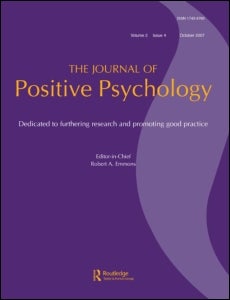
In this study, we examined loneliness and hope components as predictors of unhappy conditions (viz., anxious symptoms, depressive symptoms, & suicidal ideation) in young adults. The sample was comprised of 489 Hungarian college students. Results of conducting hierarchical regression analyses indicated that loneliness and hope pathways (but not hope agency) were important unique predictors of anxious symptoms, depressive symptoms, and suicidal ideation. Moreover, in part, consistent with the notion that hope might buffer the negative effects of loneliness on unhappy conditions, evidence for a significant Loneliness × Hope Pathways interaction effect in predicting each of the three indices of unhappy conditions was found. In contrast, the Loneliness× Hope Agency interaction effect was not found to be significant. Some implications of the present findings for the study and treatment of unhappy conditions in adults are discussed.
MEANING IN LIFE AS A PREDICTOR OF OPTIMISM: HOW PARENTS MATTERING MATTERS TO ASIAN AND EUROPEAN AMERICANS
Elizabeth A. Yu, & Edward C. Chang
Personality and Individual Differences.
The present study sought to examine the relationship between meaning in life (i.e., presence of and searching for) and optimism between Asian American and European American college students. Furthermore, we examined whether parents mattering (i.e., importance of parents’ well-being), would add to the prediction of optimism and interact with meaning in life dimensions to further predict optimism, beyond main effects. Findings indicated that meaning in life accounted for a significant amount of variance in optimism for both groups, and while Presence × Parents Mattering was a significant predictor of optimism for European Americans, Searching × Parents Mattering was a significant predictor of optimism for Asian Americans.
IMPROVING HEALTH RELATED QUALITY OF LIFE AND REDUCING SUICIDE RISK IN PRIMARY CARE: CAN SOCIAL PROBLEM SOLVING ABILITIES HELP?
Kristin L. Walker, Andrea Kaniuka, Fuschia M. Sirois, Edward C. Chang, & Jameson K. Hirsch
International Journal of Mental Health & Addiction.
Problem-solving deficits and poor health-related quality of life are associated with suicide risk; yet, little is known about the interrelations between these variables. In 220 primary care patients, we examined the potential mediating role of physical and mental health-related quality of life on the relation between social problem-solving ability and suicidal behavior. Participants completed the Suicidal Behaviors Questionnaire-Revised, Social Problem Solving Inventory-Revised, and Short-Form 36 Health Survey. Utilizing bootstrapped mediation, our hypotheses were partially supported; mediating effects were found for mental health related quality of life on the relation between social problem solving and suicidal behavior. Physical health-related quality of life was not a significant mediator. Greater social problem-solving ability is associated with better mental health related quality of life and, in turn, to less suicidal behavior. Interventions promoting social problem-solving ability may increase quality of life and reduce suicide risk in primary care patients.
RELATIONSHIP BETWEEN POSITIVE MOOD AND LIFE SATISFACTION IN WESTERNERS AND EASTERNERS: IS FEELING GOOD ASSOCIATED WITH BUILDING AGENCY, BROADENING PATHWAYS, OR BOTH?
Edward C. Chang, Olivia D. Chang, & Shanmukh V. Kamble
Journal of Happiness Studies.
The present study sought to determine if the positive association between positive mood and life satisfaction can be understood as a function of hope. Consistent with the broaden-and-build model of positive emotions, we tested the hypothesis that positive mood would be associated with broadening hope agency, building hope pathways, or both, in Western and Eastern cultural groups, namely, in an adult sample of European Americans (N = 228) and Asian Indians (N = 192), respectively. Results examining for bootstrapped mediation testing with multiple mediators indicated one consistent pattern across both groups. Specifically, positive mood was indirectly associated with life satisfaction through hope agency, but not through hope pathways. In addition, the initial association between positive mood and life satisfaction became nonsignificant once hope was included as a mediator for Asian Indians, but not for European Americans. In contrast, positive mood remained a significant predictor of life satisfaction for European Americans. Overall, the present findings suggest that one pan-cultural way in which positive mood might foster life satisfaction is by activating people’s belief that they have the ability to achieve their future goals. Some implications of the present findings are discussed.
PERFECTIONISM AND SOCIAL PROBLEM SOLVING AS PREDICTORS OF NON-SUICIDAL SELF-INJURY IN ETHNORACIALLY DIVERSE COLLEGE STUDENTS: FINDINGS CONTROLLING FOR CONCOMITANT SUICIDE RISK
Abigael G. Lucas, Edward C. Chang, Mingqi Li, Olivia D. Chang, & Jameson K. Hirsch
Social Work.
The present study was designed to examine the extent to which perfectionism and social problem solving add to the prediction model of NSSI, independent of suicide risk, in a sample of 386 ethnoracially diverse college students. Moreover, we were interested in whether social problem solving, beyond perfectionism, would account for additional variance in our prediction model. Results indicated that social problem solving did account for significant variance in the prediction model of NSSI, above and beyond perfectionism. The present findings have theoretical implications for perfectionism and social problem solving, and also practical implications for social workers that work with college students engaging in NSSI behaviors.
HOW FUTURE ORIENTATION IS ASSOCIATED WITH DEPRESSIVE SYMPTOMS IN MULTIETHNORACIAL ADULTS: BASIC PSYCHOLOGICAL NEEDS AS A MEDIATOR
Edward C. Chang, Olivia D. Chang, Elizabeth A. Yu, Kaidi Wu, Abigael G. Lucas, P. Priscilla Lui, David Rollock, Xinjie Chen, Jameson, K. Hirsh, & Elizabeth L. Jeglic
The Journal of Psychology: Interdisciplinary and Applied.
We examined the role of basic psychological needs as a mediator of the association between future orientation and depressive symptoms in a sample of 202 (159 female & 43 male) multiethnoracial adults. Participants were two hundred and two multiethnoracial adults (159 females & 43 males) with a mean age of 20.6 years. Multiple mediation analysis with 10,000 bootstraps was conducted to test for mediation. The association between future orientation and depressive symptoms was found to be accounted for by dimensions of basic psychological needs. Specifically, future orientation was negatively related to depressive symptoms through positive associations involving autonomy and competence, but not relatedness. The present findings are the first to not only point to the importance of examining future orientation in understanding depressive symptoms in multiethnoracial adults, but they are also the first to suggest possible mechanisms by which believing in a changeable future might foster stronger satisfaction with basic psychological needs, especially autonomy and competence, that might help multiethnoracials garner greater protection when encountering stressful situations in their lives.
HOW LONLINESS IS ASSOCIATED WITH DEPRESSIVE SYMPTOMS IN SPANISH COLLEGE STUDENTS: EXAMINING SPECIFIC COPING STRATEGIES AS MEDIATORS
Amaia de la Fuente, Edward C. Chang, Olga Cardeñoso, & Olivia D. Chang
The Spanish Journal of Psychology.
In this study, we examined coping strategies as a mediator of the association between loneliness and depressive symptoms. A sample of 364 Spanish young adults (75.5% females) completed measures of loneliness, coping, and depressive symptoms. In general, results from computing correlations (controlling for gender) indicated that loneliness was negatively associated with the use of one engaged coping strategy (viz., problem solving) and positively associated with the use of disengaged coping strategies (e.g., problem avoidance). A multiple mediation analysis (controlling for gender) was conducted to test for mediation. Results of this analysis indicated that part of the association between loneliness and depressive symptoms can be explained by the use of one engaged coping strategy (viz., problem solving; indirect effect, p < .05) and a variety of disengaged coping strategies (viz., problem avoidance, wishful thinking, social withdrawal, & self criticism; indirect effects, p < .05). Overall, the prediction model including loneliness and coping strategies was found to account for a large (f² = .68) 40.5% of the variance in depressive symptoms in Spanish young adults. The present findings are the first to clarify how the association between loneliness and depressive symptoms in Spanish young adults might be due in part to the use of different coping strategies. Some implications for theory and practice are discussed.
RELATIONSHIP BETWEEN INTERPERSONAL VIOLENCE VICTIMIZATION AND SUICIDE RISK IN INDIAN COLLEGE STUDENTS: DOES PRIOR EXPOSURE TO INTERPERSONAL VIOLENCE ALSO MATTER?
Edward C. Chang, Shanmukh V. Kamble, Mingqi Li, Zihao Zhou, Jeff Z. Yang, Tianbi Duan, Casey N.-H. Batterbee, & Olivia D. Chang
International Social Work.
 We examined interpersonal violence victimization and prior interpersonal violence exposure as predictors of suicide risk, namely, suicide ideation and suicide attempt, in a sample of 207 Indian college students. Results of regression analyses indicated that interpersonal violence victimization, but not prior interpersonal violence exposure, was a unique predictor of suicide risk, independent of age and sex. Finally, we found support for a significant Interpersonal Violence Victimization × Past Interpersonal Violence Exposure interaction effect consistent with the notion that the association between interpersonal violence victimization and suicide risk is potentiated by the presence of prior interpersonal violence exposure among Indian students.
We examined interpersonal violence victimization and prior interpersonal violence exposure as predictors of suicide risk, namely, suicide ideation and suicide attempt, in a sample of 207 Indian college students. Results of regression analyses indicated that interpersonal violence victimization, but not prior interpersonal violence exposure, was a unique predictor of suicide risk, independent of age and sex. Finally, we found support for a significant Interpersonal Violence Victimization × Past Interpersonal Violence Exposure interaction effect consistent with the notion that the association between interpersonal violence victimization and suicide risk is potentiated by the presence of prior interpersonal violence exposure among Indian students.
HOPE ABOVE RACIAL DISCRIMINATION AND SOCIAL SUPPORT IN ACCOUNTING FOR POSITIVE AND NEGATIVE PSYCHOLOGICAL ADJUSTMENT IN AFRICAN AMERICAN ADULTS: IS “KNOWING YOU CAN DO IT” AS IMPORTANT AS “KNOWING HOW YOU CAN”?
Edward C. Chang, Olivia D. Chang, David Rollock, P. Priscilla Lui, Angela F. Watkins, Jameson K. Hirsch, & Elizabeth L. Jeglic
Cognitive Therapy and Research.
In the present study, we examined the role of racial discrimination, social support (viz., family & friends), and hope (viz., agency & pathways) in accounting for negative psychological adjustment (viz., anxious & depressive symptoms) and positive psychological adjustment (viz., vitality & life satisfaction) in a sample of 249 African Americans. Overall, results of conducting a series of hierarchical regression analyses provided some evidence for the role of racial discrimination and social support in accounting for both negative and positive psychological adjustment. Noteworthy, the inclusion of hope was found to significantly augment the prediction models of psychological adjustment. Within the hope set, agency was consistently found to uniquely account for adjustment. In contrast, pathways was only found to uniquely account for vitality. Beyond affirming the importance of racial discrimination and social support, the present findings highlight the added value of considering hope, especially agency, in understanding positive and negative psychological adjustment in African Americans. Implications of the present findings for understanding the role of racial discrimination, social support, and hope in the psychological adjustment of African American adults are discussed.
RELATIONSHIP BETWEEN HOPE AND QUALITY OF LIFE AMONG PRIMARY CARE PATIENTS: EXAMINING VITALITY AS AN EXPLANATORY MECHANISM
Abigael G. Lucas, Edward C. Chang, Lily E. Morris, Harrison D. Angoff, Olivia D. Chang, Ashley H. Duong, Mingqi Li, & Jameson K. Hirsch
Social Work.
The present study examined the role of vitality as a mediator of the association between dispositional hope and quality of life (viz., physical health, psychological health, social relationships, & environment) in a sample of 101 adult primary care patients. Vitality was found to fully mediate the relationship between hope and physical health, social relationships, and environment. In addition, vitality was found to partially mediate the association between hope and psychological health. The present findings are consistent with a model in which vitality represents an important mechanism through which hope impacts quality of life in adults. Accordingly, our findings point to the importance of fostering both hope and vitality in efforts to promote positive quality of life in adults.
FUTURE ORIENTATION, DEPRESSION, SUICIDALITY, AND INTERPERSONAL NEEDS IN PRIMARY CARE OUTPATIENTS
Olivia D. Chang, Madeleine M. Batra, Vidhya Premkumar, Edward C. Chang, & Jameson K. Hirsch
Death Studies.
Based on past research findings with college students, we tested whether perceived burdensomeness and thwarted belongingness represent important mediators of the association between future orientation and suicide risk (viz., depression & suicidality) in primary care patients. We conducted a multiple mediator test in a sample of 97 primary care patients. Our results indicated that perceived burdensomeness and thwarted belongingness accounted for the negative associations present between future orientation and measures of suicide risk. These findings provide evidence for perceived burdensomeness and thwarted belongingness as mechanisms accounting for the association between future orientation and suicide risk in primary care patients.
EXAMINING COPING STRATEGIES USED BY SPANISH FEMALE SOCIAL WORK STUDENTS: EVIDENCE FOR THE IMPORTANCE OF SOCIAL PROBLEM-SOLVING ABILITIES
Amaia de la Fuente, Edward C. Chang, Olga Cardeñoso, & Olivia D. Chang
Social Work Education.
The present study examined the role of social problem-solving abilities in the coping strategies used by 310 female social work students from Spain. Results from comparative analyses of the coping strategies used by students to deal with stressful situations indicated the greater use of functional forms of coping (e.g., problem solving and cognitive restructuring), compared to dysfunctional forms of coping (e.g., problem avoidance and wishful thinking). Moreover, results from regression analyses indicated that constructive social problem-solving abilities, namely, positive problem orientation and rational problem solving, predicted the use of functional coping strategies (e.g., problem solving, cognitive restructuring, and express emotions). Alternatively, one damaging social problem-solving ability, namely, negative problem orientation, predicted the use of dysfunctional coping strategies (e.g., problem avoidance, wishful thinking, self criticism, and social withdrawal). Taken together, these findings provide an important first step for understanding what and how social problem-solving abilities might inform how social work students cope with stressful situations as they arise. Some implications for social work education and training are discussed.
FEELING GOOD—AND FEELING BAD—AFFECT SOCIAL PROBLEM-SOLVING: A TEST OF THE BROADEN-AND-BUILD MODEL IN ASIAN AMERICANS
Kaidi Wu & Edward C. Chang
Asian American Journal of Psychology.
We examined the reciprocal relationship between affect and social problem-solving in 329 Asian Americans over three months. A cross-lagged panel analysis showed initial positive affect predicted more positive problem orientation, more rational problem-solving, and less avoidance style three months later. However, the adaptive facets of problem-solving did not lead to more prospective positive affect. Further, positive affect was not the only antecedent to problem-solving. Initial negative affect also played a role and predicted more negative problem orientation. Conversely, initial negative problem orientation predicted reduced positive affect over time. Results suggest the cultural shaping of Fredrickson’s broaden-and-build model on the upward spiral effects of positive affect. Our findings underscore not only the promotion of positive affect, but also the reduction of negative affect, as avenues of intervention in cultivating effective problem-solving strategies for Asian Americans.
GOING BEYOND ETHNORACIAL DISCRIMINATION AND SOCIAL SUPPORT IN ACCOUNTING FOR PSYCHOLOGICAL ADJUSTMENT: EVIDENCE FOR THE IMPORTANCE OF HOPE AS A POSITIVE PSYCHOLOGICAL CONSTRUCT IN MULTIETHNORACIAL ADULTS
Edward C. Chang, Olivia D. Chang, Jerin Lee, Abigael G. Lucas, Mingqi Li, K. Malulani Castro, Savannah Pham, Grace Y. Cho, Yena S. Purmasir, Elizabeth A. Yu, Kaidi Wu, P. Priscilla Lui, David Rollock, Paul Kwon, Xinjie Chan, Jameson K. Hirsch, & Elizabeth L. Jeglic
The Journal of Positive Psychology.

In the present study, we examined the role of ethnoracial discrimination, social support (viz., family & friends), and hope (viz., agency & pathways) in accounting for negative psychological adjustment (viz., worry & depressive symptoms) and positive psychological adjustment (viz., vitality & life satisfaction) in a sample of 203 (164 females & 39 males) multiethnoracial adults. Results of conducting a series of hierarchical regression analyses indicated that beyond ethnoracial discrimination and social support, the inclusion of hope was found to augment the prediction model of psychological adjustment. Within the hope set, agency was found to be uniquely associated with adjustment. Pathways was found to be uniquely associated with positive indices of psychological adjustment. The present findings are the first to highlight the significance of hope in multiethnoracial adults. Some implications of the present findings for understanding psychological adjustment in multiethnoracial adults are discussed.
DEPRESSION, LONELINESS, AND SUICIDE RISK IN LATIONS: A TEST OF A PSYCHOSOCIAL INTERACTIN MODEL
Edward C. Chang, Olivia D. Chang, Abigael G. Lucas, Mingqi Li, Collin B. Beavan, Rachel S. Eisner, Brianna M. McManamon, Natalia S. Rodriquez, Olivia M. Katamanin, Eliza C. Bourke, Amaia de la Fuente, Olga Cardeñoso, Kaidi Wu, Elizabeth A. Yu, Elizabeth L. Jeglic, & Jameson K. Hirsch
Social Work.
This volume is the first comprehensive and interdisciplinary text to holistically improve understanding of the health of South Asians residing in the United States by considering biological, psychological, and sociocultural factors of health. The vast literatures of diverse fields – psychology, medicine, public health, social work, and health policy – are integrated by leading scholars, scientists, and practitioners in these areas to explore the impact of South Asian cultural factors on health, health risk, and illness. Chapters incorporate available theoretical and empirical information on the status of chronic health conditions in South Asians in the United States, with consideration of future directions to improve understanding of the health of this group. Cultural and ethnic insights imperative for clinical/community/medical practitioners to provide effective and culturally-appropriate care and treatment from an interdisciplinary lens are provided.
BIOPSYCHOSOCIAL APPROACHES TO UNDERSTANDING HEALTH IN SOUTH ASIAN AMERICANS
Marisa J. Perera & Edward C. Chang
Springer.
This volume is the first comprehensive and interdisciplinary text to holistically improve understanding of the health of South Asians residing in the United States by considering biological, psychological, and sociocultural factors of health. The vast literatures of diverse fields – psychology, medicine, public health, social work, and health policy – are integrated by leading scholars, scientists, and practitioners in these areas to explore the impact of South Asian cultural factors on health, health risk, and illness. Chapters incorporate available theoretical and empirical information on the status of chronic health conditions in South Asians in the United States, with consideration of future directions to improve understanding of the health of this group. Cultural and ethnic insights imperative for clinical/community/medical practitioners to provide effective and culturally-appropriate care and treatment from an interdisciplinary lens are provided.
TREATING DEPRESSION, ANXIETY, AND STRESS IN ETHNIC AND RACIAL GROUPS: COGNITIVE BEHAVIORAL APPROACHES
Edward C. Chang, Christina A. Downey, Jameson K. Hirsch, & Elizabeth A. Yu
American Psychological Association.
Depression, anxiety, and stress are responsible for an overwhelming number of mental health care visits, and cognitive behavior therapy (CBT) is the most common empirically supported treatment for these conditions. Yet little is known about the effectiveness of CBT with African Americans, Latinos, Asian Americans, and Native Americans—ethnic and racial groups comprising nearly half of the U.S. population. In this volume, Chang, Downey, Hirsch, and Yu show therapists how to adapt cognitive behavioral treatments for use with racial and ethnic minority clients. Contributors demonstrate how a client’s particular sociocultural background contextualizes his or her experience and understanding of mental health issues. They examine the influence of sociocultural context on experiences of social anxiety among Asian Americans, the role of racial identity in the way stress and anxiety are experienced by African American clients, and much more.
PARENT-CHILD CLOSENESS AND PARENTS’ MEANING IN LIFE IN PERSONAL MEANING IN LIFE: EXAMINING ETHNIC DIFFERENCES
Elizabeth A. Yu & Edward C. Chang
The Family Journal.
We examined for ethnic differences in how parent-child closeness and parents’ meaning in life predict personal meaning in life between 187 Asian American and 201 European American college students. Results indicated that parent-child closeness predicted a significant amount of variance in personal meaning in life for both groups. Furthermore, parents’ meaning in life added a significant amount of variance, above and beyond parent-child closeness, in predicting personal meaning in life for Asian Americans, but not for European Americans. Our findings indicate that although parents play some role in contributing to college-aged individuals’ meaning in life, there are still important ethnocultual nuances to consider. Findings from the present study provide a foundation for further research to continue examining the role of parents and familial relationships in meaning in life and other well-being outcomes. Further discussion of the study’s findings and implications are discussed.
FORGIVENESS AND SUICIDAL BEHAVIOR IN PRIMARY CARE: MEDIATING ROLE OF FUTURE ORIETATION
Jessica Kelliher Rabon, Jon R. Webb, Edward C. Chang, & Jameson K. Hirsch
Journal of Spirituality in Mental Health.
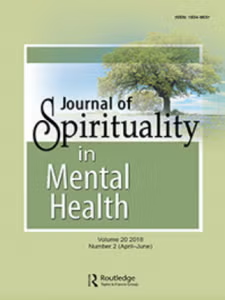 Forgiveness, a cognitive-emotional and behavioral reduction of negative responses to offenses, is directly related to less suicide risk, but may be indirectly related via its relation with future orientation, the ability to envision a positive future. In 100 rural primary care patients, we examined the association between self-forgiveness, other-forgiveness, and forgiveness by God and suicidal behavior, with future orientation as a mediator. Forgiveness was related to greater future orientation and, in turn, to less suicidal behavior. Addressing the past may promote adaptive views of the future and reduce suicide risk, results suggesting potential temporal and forgiveness-based points for suicide prevention.
Forgiveness, a cognitive-emotional and behavioral reduction of negative responses to offenses, is directly related to less suicide risk, but may be indirectly related via its relation with future orientation, the ability to envision a positive future. In 100 rural primary care patients, we examined the association between self-forgiveness, other-forgiveness, and forgiveness by God and suicidal behavior, with future orientation as a mediator. Forgiveness was related to greater future orientation and, in turn, to less suicidal behavior. Addressing the past may promote adaptive views of the future and reduce suicide risk, results suggesting potential temporal and forgiveness-based points for suicide prevention.
POSITIVE EXPECTANCIES FOR THE FUTURE AS POTENTIAL PROTECTIVE FACTORS OF SUICIDE RISK IN ADULTS: DOES OPTIMISM AND HOPE PREDICT SUICIDAL BEHAVIORS IN PRIMARY CARE PATIENTS?
Abigael G. Lucas, Edward C. Chang, Jerin Lee, & Jameson K. Hirsch
International Journal of Mental Health and Addiction.
 The present study sought to examine optimism and hope as predictors of suicidal behaviors (viz., suicide ideation & suicide attempt) in a sample of 179 adult primary care patients. Furthermore, we aimed to determine if the combination of hope and optimism would account for additional variance in the prediction model for suicidal behaviors among this population. In this cross-sectional study, participants completed measures of hope (viz., agency and pathways), optimism, and suicidal behaviors, as well as a series of demographics questions. Hierarchical regression analyses were conducted to test the aforementioned hypotheses. Results indicated that hope and optimism were both significant and unique predictors of suicidal behaviors among adult primary care patients. However, the Hope by Optimism interaction terms were not found to be significant. Some implications of the present findings are discussed.
The present study sought to examine optimism and hope as predictors of suicidal behaviors (viz., suicide ideation & suicide attempt) in a sample of 179 adult primary care patients. Furthermore, we aimed to determine if the combination of hope and optimism would account for additional variance in the prediction model for suicidal behaviors among this population. In this cross-sectional study, participants completed measures of hope (viz., agency and pathways), optimism, and suicidal behaviors, as well as a series of demographics questions. Hierarchical regression analyses were conducted to test the aforementioned hypotheses. Results indicated that hope and optimism were both significant and unique predictors of suicidal behaviors among adult primary care patients. However, the Hope by Optimism interaction terms were not found to be significant. Some implications of the present findings are discussed.
PERSONAL GROWTH INITIATIVE AND LIFE SATISFACTION IN CHINESE AND AMERICAN STUDENTS: SOME EVIDENCE FOR USING RESOURCES IN THE EAST AND BEING PLANFUL IN THE WEST
Edward C. Chang, Hongfei Yang, Mingqi Li, Tianbi Duan, Yifan Dai, Jeff Z. Yang, Zihao Zhou, Xiaping Zheng, Lily E. Morris, Kaidi Wu, & Olivia D. Chang
Journal of Well-Being Assessment.
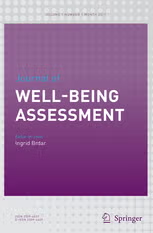 This study examined for cultural variations in personal growth initiative as a predictor of life satisfaction between 176 Chinese and 168 American college students. Comparative analyses of the personal growth initiative dimensions indicated lower readiness for change and planfulness, but higher using resources in Chinese, than in Americans. Results of regression analyses indicated that using resources was a unique predictor for Chinese, whereas planfulness was a unique predictor for Americans. Overall, these findings provide support for the global value of personal growth initiative as a positive psychological construct while also highlighting important cultural differences between Easterners and Westerners.
This study examined for cultural variations in personal growth initiative as a predictor of life satisfaction between 176 Chinese and 168 American college students. Comparative analyses of the personal growth initiative dimensions indicated lower readiness for change and planfulness, but higher using resources in Chinese, than in Americans. Results of regression analyses indicated that using resources was a unique predictor for Chinese, whereas planfulness was a unique predictor for Americans. Overall, these findings provide support for the global value of personal growth initiative as a positive psychological construct while also highlighting important cultural differences between Easterners and Westerners.
UNDERSTANDING THE ASSOCIATION BETWEEN SPIRITUALITY, RELIGIOSITY, AND FEELINGS O HAPPINESS AND SADNESS AMONG HIV-POSITIVE INDIAN ADULTS: EXAMINING STRESS-RELATED GROWTH AS A MEDIATOR
Edward C. Chang, Tina Yu, Jerin Lee, Shanmukh V. Kamble, Casey N.-H. Batterbee, Kayla R. Stam, Olivia D. Chang, Alexandria S.-M. Najarian, & Kaitlin M. Wright
Journal of Religion and Health.
This study examined the role of stress-related growth as a mediator of the associations between spirituality, religiosity, and feelings of happiness and sadness in a sample of 178 HIV-positive Indian adults. Results indicated that spirituality, but not religiosity, was associated with feelings of happiness and sadness. Subsequent mediation analyses indicated that stress-related growth fully mediated the relationships involving spirituality and feelings of happiness and sadness. Overall, our findings point to the importance of facilitating greater spiritual development among HIV-positive Indians, as well as promoting strategies that help them develop and apply stress-related growth coping methods in their lives.
ACADEMIC MOTIVATION AND PSYCHOLOGICAL NEEDS AS PREDICTORS OF SUICIDAL RISK
Jerin Lee, Edward C. Chang, Abigael G. Lucas, & Jameson K. Hirsch
Journal of College Counseling.
The present study examined academic motivation and basic psychological needs as predictors of suicidal risk (viz., depressive symptoms & suicidal behaviors) in a sample of 348 college students. Results from regression analyses indicated that academic motivation was a significant predictor of suicidal risk. Importantly, the inclusion of basic psychological needs significantly augmented the prediction model. Some important implications for considering academic motivation and basic psychological needs in college counseling are discussed.
PRESENCE OF TRAUMA AND SUICIDE RISK: PERSONAL CONTROL AS A MODERATOR
Edward C. Chang, Abigael G. Lucas, Olivia D. Chang, Tianbi Duan, Zihao Zhou, Jeff Z. Yang, Lily E. Morris, Harrison D. Angoff, & Jameson K. Hirsch
Death Studies.
Given past findings that have linked trauma and lack of personal control to greater suicidal risk in adults, the present study examined how trauma presence and personal control are uniquely involved in predicting suicidal risk in a sample of 469 college students. Regression analyses indicated that both trauma presence and personal control were significant predictors of suicidal risk, as did their interaction. The present findings suggest a need to consider both trauma presence and low personal control in assessing for suicidal risk in college students.
ETHNIC IDENTITY AND LONELINESS IN PREDICTING SUICIDE RISK IN LATINO COLLEGE STUDENTS
Edward C. Chang, Lizbeth Díaz, Abigael G. Lucas, Jerin Lee, Nicholas J. Powell, Sally Kafelghazal, Sarah J. Chartier, Lily E. Morris, Tey’Ariana M. Marshall-Broaden, Jameson K. Hirsch, & Elizabeth L. Jeglic
Hispanic Journal of Behavioral Sciences.
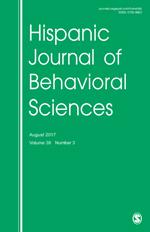
The present study was conducted to examine the role of ethnic identity and loneliness as predictors of suicide risk, namely, hopelessness and suicidal behaviors, in Latino college students. Results of conducting regression analyses indicated that ethnic identity was a significant predictor of suicide risk. When loneliness was added into the regression model, it was found to account for a significant amount of incremental variance in both of the suicide risk indices. Some implications for incorporating ethnic identity and loneliness in working with Latino college students are discussed.
PERCEIVED STRESS AND SUICIDAL BEHAVIORS IN COLLEGE STUDENTS: CONDITIONAL INDIRECT EFFECTS OF DEPRESSIVE SYMPTOMS AND MENTAL HEALTH STIGMA
Jameson K. Hirsch, Jessica Kelliher Rabon, Esther E. Reynolds, Alison L. Barton, & Edward C. Chang
Stigma and Health.

Suicide is a significant public health concern, and the second leading cause of death for college students. Perceived stress, depression, and mental health stigma are established risk factors for suicidal behavior; however, their interrelationships are unknown. Data was collected from 913 collegiate housing residents (70.8% female; n = 646). Using data from self-report measures, depressive symptoms were examined as a mediator of the relation between stress and suicidal behavior, along with the moderating effect of mental health stigma. Depressive symptoms partially mediated the stress-suicide linkage, and mental health stigma was a significant moderator of the associations between stress and depression, depression and suicidal behavior, and stress and suicidal behavior. Stigmatized attitudes toward mental health treatment, including fear of social repercussion, may exacerbate the deleterious impact of stress on psychopathology and suicide risk. Addressing mental health stigma may buffer the transition from stress to suicidal outcomes.
RELATIONSHIP BETWEEN LONELINESS AND SYMPTOMS OF ANXIETY AND DEPRESSION IN AFRICAN MEN AND WOMEN: EVIDENCE FOR GENDER AS A MODERATOR
Edward C. Chang
Personality and Individual Differences.
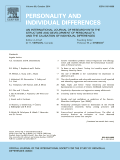 We examined for gender differences in loneliness and negative affective conditions, namely, symptoms of anxiety and depression, in 168 African American college students. Gender differences were examined as a predictor of negative affective conditions and as a moderator of the relationship between loneliness and negative affective conditions. Although no significant differences were found in levels of loneliness and negative affective conditions between African American men and women, results of regression analyses indicated that gender differences significantly predicted anxious and depressive symptoms. Moreover, a significant Gender × Loneliness interaction effect was found in predicting both anxious and depressive symptoms. Specifically, higher levels of anxious and depressive symptoms were found among lonely African American women, compared to men. These findings suggest that the negative psychological effects of loneliness may be particularly more damaging for African American women than men. Understanding the unique challenges of African American women, compared to men, as a double minority is discussed.
We examined for gender differences in loneliness and negative affective conditions, namely, symptoms of anxiety and depression, in 168 African American college students. Gender differences were examined as a predictor of negative affective conditions and as a moderator of the relationship between loneliness and negative affective conditions. Although no significant differences were found in levels of loneliness and negative affective conditions between African American men and women, results of regression analyses indicated that gender differences significantly predicted anxious and depressive symptoms. Moreover, a significant Gender × Loneliness interaction effect was found in predicting both anxious and depressive symptoms. Specifically, higher levels of anxious and depressive symptoms were found among lonely African American women, compared to men. These findings suggest that the negative psychological effects of loneliness may be particularly more damaging for African American women than men. Understanding the unique challenges of African American women, compared to men, as a double minority is discussed.
THE RELATIONSHIP BETWEEN DOMESTIC PARTNER VIOLENCE AND SUICIDAL BEHAVIORS IN AN ADULT COMMUNITY SAMPLE: HOPE AGENCY AND PATHWAYS AS PROTECTIVE FACTORS
Edward C. Chang, Elizabeth A. Yu, Emma R. Kahle, Yifeng Du, Olivia D. Chang, Zunaira Jilani, Tina Yu, & Jameson K. Hirsch
Violence Against Women.
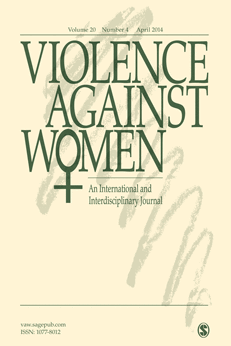
We examined an additive and interactive model involving domestic partner violence (DPV) and hope in accounting for suicidal behaviors in sample of 98 community adults. Results showed that DPV accounted for a significant amount of variance in suicidal behaviors. Hope further augmented the prediction model and accounted for suicidal behaviors beyond DPV. Finally, we found that DPV significantly interacted with both dimensions of hope to further account for additional variance in suicidal behaviors above and beyond the independent effects of DPV and hope. Implications for the role of hope in the relationship between DPV and suicidal behaviors are discussed.
A PRELIMINARY EXAMINTION OF NEGATIVE LIFE EVENTS AND SEXUAL ASSAULT VICTIMIZATION AS PREDICTORS OF PSYCHOLOGICAL FUNCTIONING IN FEMALE COLLEGE STUDENTS: DOES ONE MATTER MORE THAN THE OTHER?
Edward C. Chang, Jerin Lee, Lily E. Morris, Abigael G. Lucas, Olivia D. Chang, & Jameson K. Hirsch
Journal of Interpersonal Violence.
 The present study examined negative life events (NLE) and sexual assault victimization as predictors of positive and negative psychological functioning in a sample of 151 female college students. Results obtained from conducting regression analyses indicated several notable patterns. NLE, compared to sexual assault victimization, was a stronger negative predictor of positive functioning based on indices related to subjective well-being (e.g., life satisfaction, positive affect). Alternatively, sexual assault victimization, compared to negative life events, was a stronger positive predictor of negative functioning based on indices related to Posttraumatic Stress Disorder symptoms (e.g., anxiety) and related conditions (e.g., alcohol use). Furthermore, both negative life events and sexual assault victimization were found to be positive predictors of negative functioning based on indices related to suicide risk (e.g., depressive symptoms, suicidal behaviors). Overall, our findings indicate that both negative life events and sexual assault victimization represent important and distinct predictors of psychological functioning in female college students.
The present study examined negative life events (NLE) and sexual assault victimization as predictors of positive and negative psychological functioning in a sample of 151 female college students. Results obtained from conducting regression analyses indicated several notable patterns. NLE, compared to sexual assault victimization, was a stronger negative predictor of positive functioning based on indices related to subjective well-being (e.g., life satisfaction, positive affect). Alternatively, sexual assault victimization, compared to negative life events, was a stronger positive predictor of negative functioning based on indices related to Posttraumatic Stress Disorder symptoms (e.g., anxiety) and related conditions (e.g., alcohol use). Furthermore, both negative life events and sexual assault victimization were found to be positive predictors of negative functioning based on indices related to suicide risk (e.g., depressive symptoms, suicidal behaviors). Overall, our findings indicate that both negative life events and sexual assault victimization represent important and distinct predictors of psychological functioning in female college students.
LOSS OF HOPE AND SUICIDE RISK IN HUNGARIAN COLLEGE STUDENTS: HOW THE PRESENCE OF PERCEIVED FAMILY SUPPORT MAKES A POSITIVE DIFFERENCE
Edward C. Chang, Olivia D. Chang, Tamás Martos, & Viola Sallay
The Family Journal.
We examined hope and family support as predictors of suicide risk (viz., anxious symptoms, depressive symptoms, & suicide ideation) in a sample of 502 Hungarian college students. Results of hierarchical regression analyses indicated that the inclusion of family support provided further incremental validity in predicting all three indices of suicide risk, beyond the variance accounted for by hope. Consistent with the notion that family support might moderate the beneficial effects of hope on suicide risk, evidence for a significant Hope × Family Support interaction effect in predicting all three indices of suicide risk was found. Additionally, a significant interaction effect in predicting suicide ideation remained, even after controlling for psychological symptoms. Beyond the role of hope in predicting suicide risk in Hungarian college students, the present findings show how family support both additively and interactively represents a positive psychological resource that should be considered in understanding suicide risk among students.
DOES OPTIMISM WEAKEN THE NEGATIVE EFFECTS OF BEING LONELY ON SUICIDE RISK?
Edward C. Chang, Olivia D. Chang, Tamás Martos, Viola Sallay, Xiaoqing Li, Abigael G. Lucas, & Jerin Lee
Death Studies.
The present study investigated loneliness and optimism as predictors of suicide risk, specifically, depressive symptoms and suicidal ideation, in 457 Hungarian college students. Beyond the expected role of loneliness in suicide risk, being optimistic buffered the positive association between loneliness and suicide. Our findings implicate the importance of fostering optimism for potentially lowering suicide risk among lonely college students.
NON-SUICIDAL SELF-INJURY AND SUICIDAL BEHAVIOR IN A DIVERSE SAMPLE: THE MODERATING ROLE OF SOCIAL PROBLEM-SOLVING ABILITY
Kristin L. Walker, Jameson K. Hirsch, Edward C. Chang, & Elizabeth L. Jeglic
International Journal of Mental Health and Addiction.
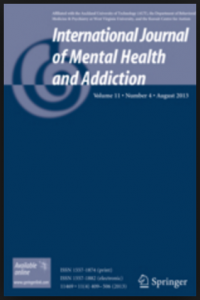 Non-suicidal self-injury and suicidal behavior are prevalent in young adults, and often constitute a continuum of self-destructiveness. Not all those who self-injure, however, engage in suicidal behaviors with intent to die, perhaps due to protective intrapersonal characteristics. Aims: We examined the role of one such potential buffer, social problem solving ability, as a moderator of the association between non-suicidal self-injury and suicidal thoughts and attempts, hypothesizing that individuals with greater social problem solving ability would report fewer suicidal behaviors in relation to self-harm. Methods: An ethnically diverse sample was recruited from a large, Northeastern urban university, and completed self-report questionnaires assessing non-suicidal self-injury, suicidal behaviors, and social problem solving ability. Multivariate hierarchical regression analyses were conducted. Results: For the entire sample, individuals with higher social problem solving abilities reported fewer suicidal behaviors associated with non-suicidal self-injury. In ethnically stratified analyses, social problem solving significantly moderated the relationship between self-injury and suicidal behaviors for Whites and Hispanics only. Conclusions: Promotion of problem-solving skills may weaken the linkage between self-injury and potential for future suicidal behaviors for some individuals; however, culture-specific differences in this effect may exist.
Non-suicidal self-injury and suicidal behavior are prevalent in young adults, and often constitute a continuum of self-destructiveness. Not all those who self-injure, however, engage in suicidal behaviors with intent to die, perhaps due to protective intrapersonal characteristics. Aims: We examined the role of one such potential buffer, social problem solving ability, as a moderator of the association between non-suicidal self-injury and suicidal thoughts and attempts, hypothesizing that individuals with greater social problem solving ability would report fewer suicidal behaviors in relation to self-harm. Methods: An ethnically diverse sample was recruited from a large, Northeastern urban university, and completed self-report questionnaires assessing non-suicidal self-injury, suicidal behaviors, and social problem solving ability. Multivariate hierarchical regression analyses were conducted. Results: For the entire sample, individuals with higher social problem solving abilities reported fewer suicidal behaviors associated with non-suicidal self-injury. In ethnically stratified analyses, social problem solving significantly moderated the relationship between self-injury and suicidal behaviors for Whites and Hispanics only. Conclusions: Promotion of problem-solving skills may weaken the linkage between self-injury and potential for future suicidal behaviors for some individuals; however, culture-specific differences in this effect may exist.
APPLYING THE BROADEN-AND-BUILD MODEL OF POSITIVE EMOTIONS TO SOCIAL PROBLEM SOLVING: DOES FEELING GOOD (VS. FEELING BAD) INFLUENCE PROBLEM ORIENTATION, PROBLEM-SOLVING SKILLS, OR BOTH?
Edward C. Chang
Journal of Social and Clinical Psychology.
 The present study sought to determine if positive mood plays a role in broadening and building key components of social problem solving, namely, problem orientation and problem-solving skills, respectively, in a sample of 205 college students. Results from regression analyses indicated that positive affect at baseline predicted both positive and negative problem orientation 2 months later, even after controlling for concurrent affect. In contrast, positive affect at baseline did not predict problem-solving skills. Interestingly, results from these analyses also indicated that negative affect at baseline predicted one dimension of problem orientation, namely, positive problem orientation, and two dimensions of problem-solving skills, namely, rational problem solving and impulsive/carelessness style. On the one hand, the present findings offer support for the notion that positive affect, relative to negative affect, is strongly involved in problem orientation. On the other hand, however, they support the notion that negative affect, compared to positive affect, is strongly involved in problem-solving skills. Some implications of the present findings for cultivating effective problem-solving ability are discussed.
The present study sought to determine if positive mood plays a role in broadening and building key components of social problem solving, namely, problem orientation and problem-solving skills, respectively, in a sample of 205 college students. Results from regression analyses indicated that positive affect at baseline predicted both positive and negative problem orientation 2 months later, even after controlling for concurrent affect. In contrast, positive affect at baseline did not predict problem-solving skills. Interestingly, results from these analyses also indicated that negative affect at baseline predicted one dimension of problem orientation, namely, positive problem orientation, and two dimensions of problem-solving skills, namely, rational problem solving and impulsive/carelessness style. On the one hand, the present findings offer support for the notion that positive affect, relative to negative affect, is strongly involved in problem orientation. On the other hand, however, they support the notion that negative affect, compared to positive affect, is strongly involved in problem-solving skills. Some implications of the present findings for cultivating effective problem-solving ability are discussed.
PERFECTIONISM AND LONELINESS AS DEPRESSIVE AND ANXIOUS SYMPTOMS IN AFRICAN AMERICAN ADULTS: FURTHER EVIDENCE FOR A TOP-DOWN ADDITIVE MODEL
Edward C. Chang
Cognitive Therapy and Research.
 In the present study, I used a top-down approach to examine perfectionism and loneliness as additive predictors of depressive and anxious symptoms in a sample of 168 African American college students. Consistent with expectations, I found perfectionism and loneliness to be associated with both depressive and anxious symptoms. In addition, results of conducting hierarchical regression analyses indicated that certain dimensions of perfectionism, especially doubts about actions, accounted for significant variance in both depressive and anxious symptoms. Moreover, the inclusion of loneliness as a predictor was found to predict additional unique variance in both depressive and anxious symptoms, beyond what was accounted for by perfectionism. Implications of the present findings for future research on negative affective conditions in African American adults are discussed.
In the present study, I used a top-down approach to examine perfectionism and loneliness as additive predictors of depressive and anxious symptoms in a sample of 168 African American college students. Consistent with expectations, I found perfectionism and loneliness to be associated with both depressive and anxious symptoms. In addition, results of conducting hierarchical regression analyses indicated that certain dimensions of perfectionism, especially doubts about actions, accounted for significant variance in both depressive and anxious symptoms. Moreover, the inclusion of loneliness as a predictor was found to predict additional unique variance in both depressive and anxious symptoms, beyond what was accounted for by perfectionism. Implications of the present findings for future research on negative affective conditions in African American adults are discussed.
LONELINESS AND SUICIDAL RISK IN YOUNG ADULTS: DOES BEIEVING IN A CHANGEABLE FUTURE HELP MINIMIZE SUICIDAL RISK AMONG THE LONELY?
Edward C. Chang, Liangqiu Wan, Pengzi Li, Yuncheng Guo, Jiaying He, Yu Gu, Yingjie Wang, Xiaoqing Li, Zhan Zhang, Yingrui Sun, Casey N.-H. Batterbee, Olivia D. Chang, Abigael G. Lucas, & Jameson K. Hirsch
The Journal of Psychology: Interdisciplinary and Applied.
 This study examined loneliness and future orientation as predictors of suicidal risk, namely, depressive symptoms and suicide ideation, in a sample of 228 college students (54 males & 174 females). Results of regression analyses indicated that loneliness was a significant predictor of both indices of suicidal risk. The inclusion of future orientation was found to significantly augment the prediction model of both depressive symptoms and suicide ideation, even after accounting for loneliness. Noteworthy, beyond loneliness and future orientation, the Loneliness × Future Orientation interaction term was found to further augment both prediction models of suicidal risk. Consistent with the notion that future orientation is an important buffer of suicidal risk, among lonely students, those with high future orientation, compared to low future orientation, were found to report significantly lower levels of depressive symptoms and suicide ideation. Some implications of the present findings for studying both risk and protective factors associated with suicidal risk in young adults are discussed.
This study examined loneliness and future orientation as predictors of suicidal risk, namely, depressive symptoms and suicide ideation, in a sample of 228 college students (54 males & 174 females). Results of regression analyses indicated that loneliness was a significant predictor of both indices of suicidal risk. The inclusion of future orientation was found to significantly augment the prediction model of both depressive symptoms and suicide ideation, even after accounting for loneliness. Noteworthy, beyond loneliness and future orientation, the Loneliness × Future Orientation interaction term was found to further augment both prediction models of suicidal risk. Consistent with the notion that future orientation is an important buffer of suicidal risk, among lonely students, those with high future orientation, compared to low future orientation, were found to report significantly lower levels of depressive symptoms and suicide ideation. Some implications of the present findings for studying both risk and protective factors associated with suicidal risk in young adults are discussed.
ATHLETIC COMPETENCE AS A CENTRAL FACET OF SPORT ORIENTATION AMONG COLLEGIATE ATHLETES
Edward C. Chang, Alexandria S.-M. Najarian, Olivia D. Chang, Gianna M. Hill, & Jerin Lee
Journal of Sport Behavior.
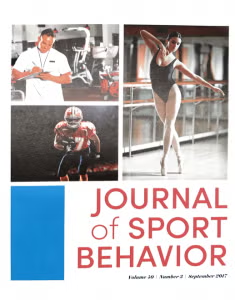
The present study examined facets of athletic identity (i.e., appearance, importance, competence, and encouragement) as predictors of sport orientation dimensions in a sample of 183 collegiate athletes (114 males & 69 females). Results from conducting correlational analyses indicated that all facets of athletic identity were positively associated with all three dimensions of sport orientation, namely competitiveness, win orientation, and goal orientation. However, results from conducting hierarchical regression analyses indicated that, independent of demographic variables (i.e., age, gender, & race/ethnicity), competence was the only unique facet of athletic identity to predict each of the three sport orientation dimensions. The present findings point to the importance of competence as a central facet underlying sport-based motivation among collegiate athletes.
HOPE AND HOPELESSNESS AS PREDICTORS OF SUICIDE IDEATION IN HUNGARIAN COLLEGE STUDENTS
Edward C. Chang
Death Studies.
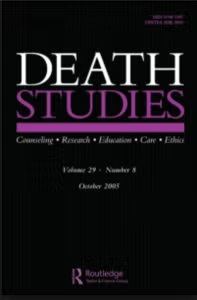 This study investigated whether hopelessness and dispositional hope predict suicide ideation in 395 Hungarian college students. Both hopelessness and hope uniquely predicted suicide ideation, a pattern that remained unchanged even after controlling for psychological symptoms. Moreover, a significant hopelessness x hope interaction predicted suicide ideation. Present findings highlight how hope buffers the association between hopelessness and suicide risk in college students.
This study investigated whether hopelessness and dispositional hope predict suicide ideation in 395 Hungarian college students. Both hopelessness and hope uniquely predicted suicide ideation, a pattern that remained unchanged even after controlling for psychological symptoms. Moreover, a significant hopelessness x hope interaction predicted suicide ideation. Present findings highlight how hope buffers the association between hopelessness and suicide risk in college students.
FUTURE ORIENTATION AND SUICIDE RISK IN HUNGARIAN COLLEGE STUDENTS: BURDENSOMENESS AND BELONGINGNESS AS MEDIATORS
Edward C. Chang, Olivia D. Chang, Tamás Martos, & Viola Sallay
Death Studies.
 We tested a model consistent with the notion that perceived burdensomeness and thwarted belongingness mediate the association between future orientation and suicide risk (viz., depressive symptoms & suicide ideation) in college students. The sample was comprised of 195 Hungarian college students. Results indicated that the negative associations found between future orientation and suicide risk outcomes were accounted for by both perceived burdensomeness and thwarted belongingness. The present findings highlight the importance of studying positive future cognitions in suicide risk, and provide support for perceived burdensomeness and thwarted belongingness as potential proximal mechanisms associated with heightened suicide risk in adults.
We tested a model consistent with the notion that perceived burdensomeness and thwarted belongingness mediate the association between future orientation and suicide risk (viz., depressive symptoms & suicide ideation) in college students. The sample was comprised of 195 Hungarian college students. Results indicated that the negative associations found between future orientation and suicide risk outcomes were accounted for by both perceived burdensomeness and thwarted belongingness. The present findings highlight the importance of studying positive future cognitions in suicide risk, and provide support for perceived burdensomeness and thwarted belongingness as potential proximal mechanisms associated with heightened suicide risk in adults.
EXAMINING OPTIMISM AND HOPE AS PROTECTIVE FACTORS OF SUICIDE RISK IN HUNGARIAN COLLEGE STUDENTS: IS RISK HIGHEST FOR THOSE LACKING POSITIVE PSYCHOLOGICAL PROTECTION?
Edward C. Chang, Tamás Martos, Viola Sallay, Olivia D. Chang, Kaitlin M. Wright, Alexandria S.-M. Najarian, & Jerin Lee
Cognitive Therapy and Research.
 A specific model involving optimism and hope as predictors of suicide risk, namely, depressive symptoms and suicide ideation, was tested in a sample of 508 (242 male & 266 female) Hungarian college students. Beyond the distinct influence of the two predictors on both depressive symptoms and suicide ideation, optimism and hope were also hypothesized to interact together to predict both outcomes. Results of regression analyses indicated that optimism and hope were significant and unique predictors of lower depressive symptoms and suicide ideation. Noteworthy, beyond optimism and hope, the Optimism × Hope interaction term was found to significantly augment the prediction of both depressive symptoms and suicide ideation. Specifically, optimists with high hope showed the highest amount of protection from depressive symptoms, but not suicide ideation. In contrast, pessimists with low hope consistently showed the least amount of protection from both depressive symptoms and suicide ideation. Some implications of the present findings for understanding protective factors of suicide risk are discussed.
A specific model involving optimism and hope as predictors of suicide risk, namely, depressive symptoms and suicide ideation, was tested in a sample of 508 (242 male & 266 female) Hungarian college students. Beyond the distinct influence of the two predictors on both depressive symptoms and suicide ideation, optimism and hope were also hypothesized to interact together to predict both outcomes. Results of regression analyses indicated that optimism and hope were significant and unique predictors of lower depressive symptoms and suicide ideation. Noteworthy, beyond optimism and hope, the Optimism × Hope interaction term was found to significantly augment the prediction of both depressive symptoms and suicide ideation. Specifically, optimists with high hope showed the highest amount of protection from depressive symptoms, but not suicide ideation. In contrast, pessimists with low hope consistently showed the least amount of protection from both depressive symptoms and suicide ideation. Some implications of the present findings for understanding protective factors of suicide risk are discussed.
EXAMINING SEXUAL ASSAULT VICTIMIZATION AND LONELINESS AS RISK FACTORS ASSOCIATED WITH NON-LETHAL SELF-HARM BEHAVIORS IN FEMALE COLLEGE STUDENTS: IS IT IMPORTANT TO CONTROL FOR CONCOMITANT SUICIDAL BEHAVIORS (AND VICE VERSA)?
Edward C. Chang, Jerin Lee, Kaitlin M. Wright, Alexandria S.-M. Najarian, Tina Yu, Olivia D. Chang, & Jameson K. Hirsch
Journal of Interpersonal Violence.
 The present study examined sexual assault victimization and loneliness as predictors of self-harm behaviors in a sample of 224 female college students. Results from conducting regression analysis indicated that both sexual assault victimization and loneliness were unique and significant predictors of self-harm behaviors. This pattern remained even after controlling for concomitant suicidal behaviors. Interestingly, in a post-hoc analysis predicting suicidal behaviors, it was found that loneliness, but not sexual assault victimization, was the only unique and significant predictor after controlling for self-harm behaviors. Some implications of the present findings for understanding self-harm behaviors in female college students and the importance of controlling for suicidal behaviors in studies of self-harm behaviors (and vice versa) are discussed.
The present study examined sexual assault victimization and loneliness as predictors of self-harm behaviors in a sample of 224 female college students. Results from conducting regression analysis indicated that both sexual assault victimization and loneliness were unique and significant predictors of self-harm behaviors. This pattern remained even after controlling for concomitant suicidal behaviors. Interestingly, in a post-hoc analysis predicting suicidal behaviors, it was found that loneliness, but not sexual assault victimization, was the only unique and significant predictor after controlling for self-harm behaviors. Some implications of the present findings for understanding self-harm behaviors in female college students and the importance of controlling for suicidal behaviors in studies of self-harm behaviors (and vice versa) are discussed.
FAMILY SUPPORT AS A MODERATOR OF THE RELATIONSHIP BETWEEN LONELINESS AND SUICIDE RISK IN COLLEGE STUDENTS: HAVING A SUPPORTIVE FAMILY MATTERS!
Edward C. Chang, Olivia D. Chang, Tamás Martos, Viola Sallay, Jerin Lee, Kayla R. Stam, Casey N.-H Batterbee, & Tina Yu
The Family Journal.
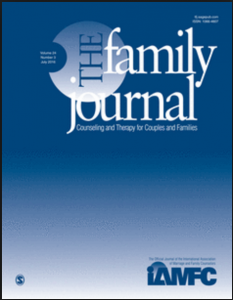 In this study, we examined loneliness and family support as predictors of suicide risk (viz., depressive symptoms & suicide ideation) in college students. The sample was comprised of 456 Hungarian college students. Results of conducting hierarchical regression analyses, controlling for sex and age, indicated that the inclusion of family support provided further incremental validity in predicting both depressive symptoms and suicide ideation, beyond the variance accounted for by loneliness. Moreover, consistent with the notion that family support might buffer the negative effects of loneliness on suicide risk, evidence for a significant Loneliness × Family Support interaction effect in predicting both indices of suicide risk was found. Thus, beyond the role of loneliness in predicting suicide risk in college students, the present findings are the first to show how family support both additively and interactively represents a positive psychological resource that should be considered in understanding suicide risk among students.
In this study, we examined loneliness and family support as predictors of suicide risk (viz., depressive symptoms & suicide ideation) in college students. The sample was comprised of 456 Hungarian college students. Results of conducting hierarchical regression analyses, controlling for sex and age, indicated that the inclusion of family support provided further incremental validity in predicting both depressive symptoms and suicide ideation, beyond the variance accounted for by loneliness. Moreover, consistent with the notion that family support might buffer the negative effects of loneliness on suicide risk, evidence for a significant Loneliness × Family Support interaction effect in predicting both indices of suicide risk was found. Thus, beyond the role of loneliness in predicting suicide risk in college students, the present findings are the first to show how family support both additively and interactively represents a positive psychological resource that should be considered in understanding suicide risk among students.
HOPE AS A MEDIATOR OF THE LINK BETWEEN INTIMATE PARTNER VIOLENCE AND SUICIDAL RISK IN TURKISH WOMEN: FURTHER EVIDENCE FOR THE ROLE OF HOPE AGENCY
Mine Muyan & Edward C. Chang
Journal of Interpersonal Violence.
 The present study examined hope as a potential mediator of the association between intimate partner violence (IPV) and suicidal risk, namely, depression and suicide ideation, in a sample of 149 Turkish female college students. Results from conducting bootstrapped mediation analyses indicated that hope agency, but not hope pathways, mediated the link between IPV and suicidal risk in Turkish women. Importantly, the associations of IPV with both depression and suicide ideation became non-significant once hope was included in the prediction model. Some implications of the present findings for hope theory and practice in the context of IPV victimization among Turkish women are discussed.
The present study examined hope as a potential mediator of the association between intimate partner violence (IPV) and suicidal risk, namely, depression and suicide ideation, in a sample of 149 Turkish female college students. Results from conducting bootstrapped mediation analyses indicated that hope agency, but not hope pathways, mediated the link between IPV and suicidal risk in Turkish women. Importantly, the associations of IPV with both depression and suicide ideation became non-significant once hope was included in the prediction model. Some implications of the present findings for hope theory and practice in the context of IPV victimization among Turkish women are discussed.
HAPPINESS AMONG HIV-POSITIVE INDIAN ADULTS: EXAMINING STRESS-RELATED GROWTH AND COPING AS PREDICTORS OF POSITIVE PSYCHOLOGICAL ADJUSTMENT
Edward C. Chang, Tina Yu, Zunaira Jilani, Olivia D. Chang, Yifeng Du, Jameson K. Hirsch, & Shanmukh V. Kamble
Asian Journal of Psychiatry.
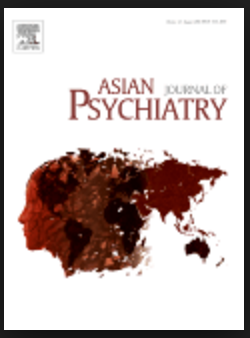 This study examined stress-related growth and emotion-focused coping as predictors of happiness and sadness in a sample of 208 HIV-positive Indian adults. For both outcomes, stress-related growth was found to be an important predictor of adjustment. Furthermore, the inclusion of emotion-focused coping behaviors were found to significantly augment the prediction models, with denial, venting, self-distraction emerging as significant unique predictors of happiness and sadness beyond stress-related growth.
This study examined stress-related growth and emotion-focused coping as predictors of happiness and sadness in a sample of 208 HIV-positive Indian adults. For both outcomes, stress-related growth was found to be an important predictor of adjustment. Furthermore, the inclusion of emotion-focused coping behaviors were found to significantly augment the prediction models, with denial, venting, self-distraction emerging as significant unique predictors of happiness and sadness beyond stress-related growth.
VALITDITY OF THE FREQUENCY OF SUICIDAL IDEATION INVENTORY IN HUNGARIAN ADULTS
Edward C. Chang, Olivia D. Chang, Tamás Martos, Viola Sallay, Alexandra S.-M. Najarian, & Jerin Lee
Death Studies.
 The present research examined the validity of the Hungarian Frequency of Suicidal Ideation Inventory (FSII-H). In Study 1, among 457 Hungarian college students, confirmatory factor analysis supported a one-factor model. In Study 2, among 241 Hungarian college students, FSII-H correlated positively with measures of suicide risk factors, and negatively with suicide protective factors. The present findings are the first to provide promising evidence for the validity of a brief measure of suicide ideation frequency in a Hungarian population.
The present research examined the validity of the Hungarian Frequency of Suicidal Ideation Inventory (FSII-H). In Study 1, among 457 Hungarian college students, confirmatory factor analysis supported a one-factor model. In Study 2, among 241 Hungarian college students, FSII-H correlated positively with measures of suicide risk factors, and negatively with suicide protective factors. The present findings are the first to provide promising evidence for the validity of a brief measure of suicide ideation frequency in a Hungarian population.
EVALUATIVE CONCERNS AND PERSONAL STANDARDS PERFECTIONSIM AS PREDICTORS OF BODY DISSATISFACTION IN ASIAN AND EUROPEAN AMERICAN FEMALE COLLEGE STUDENTS
Edward C. Chang, Tina Yu, Olivia D. Chang, & Zunaira Jilani
Journal of American College Health.
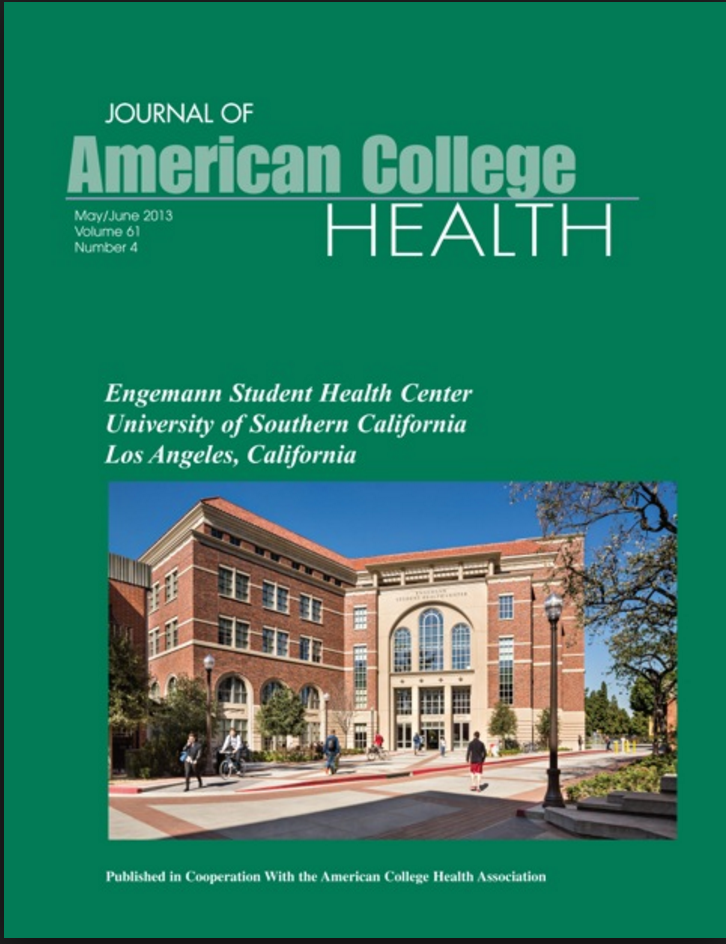 Objectives: The present study examined perfectionism (viz., evaluative concerns & personal standards) and ethnicity as predictors of body dissatisfaction in female college students. Participants: Participants were 298 female college students sampled by December of 2013. Methods: A self-report survey with measures of body dissatisfaction, perfectionism, and demographics was conducted. Results: Regression analyses indicated that evaluative concerns perfectionism (ECP) was a significant predictor of body dissatisfaction. The inclusion of ethnicity was found to further augment the prediction model. Moreover, we found support for an ECP × Ethnicity interaction effect in predicting body dissatisfaction. Specifically, among high-ECP female students, European Americans, compared to Asian Americans, reported the highest level of body dissatisfaction. Conclusion: High ECP represents a potential marker of body dissatisfaction in female college students. However, the presence of high ECP is a more critical predictor of body dissatisfaction in European American female students, compared to Asian American female students.
Objectives: The present study examined perfectionism (viz., evaluative concerns & personal standards) and ethnicity as predictors of body dissatisfaction in female college students. Participants: Participants were 298 female college students sampled by December of 2013. Methods: A self-report survey with measures of body dissatisfaction, perfectionism, and demographics was conducted. Results: Regression analyses indicated that evaluative concerns perfectionism (ECP) was a significant predictor of body dissatisfaction. The inclusion of ethnicity was found to further augment the prediction model. Moreover, we found support for an ECP × Ethnicity interaction effect in predicting body dissatisfaction. Specifically, among high-ECP female students, European Americans, compared to Asian Americans, reported the highest level of body dissatisfaction. Conclusion: High ECP represents a potential marker of body dissatisfaction in female college students. However, the presence of high ECP is a more critical predictor of body dissatisfaction in European American female students, compared to Asian American female students.
BIG 5 PERSONALITY AND SUBJECTIVE WELL-BEING IN ASIAN AMERICANS: TESTING OPTIMISM AND PESSIMISM AS MEDIATORS
Priscilla P. Lui, David Rollock, Edward C. Chang, Frederick T. L. Leong, & Byron L. Zamboanga
Asian American Journal of Psychology.
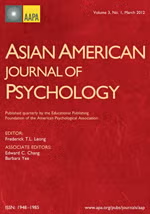 Understanding Asian Americans’ lives and challenges would be enhanced by examining group-specific contributors to subjective well-being (SWB). The components and predictors of SWB, as well as other dimensions of positive psychology, are understudied in mainstream psychological and Asian American literatures. The present study addressed this gap in the literature by (1) exploring multiple domains of SWB—hedonic, eudaimonic, social, physical, and financial well-being; (2) examining joint and distinct influences of Big 5 personality traits and outcome expectancies; and, (3) considering experiences that foster life flourishing among Asian Americans. Asian American college freshmen (N = 456; 55.56% women; Mage = 17.95 years) completed self-report measures assessing their Big 5 personality tendencies, optimism and pessimism, and SWB. Confirmatory factor analytic (CFA) findings supported the notion that SWB could be conceptualized as comprised of five distinct but related domains. CFAs also indicated that optimism and pessimism were partially independent constructs. Structural equation models indicated that extraversion, conscientiousness, and agreeableness were stronger predictors for domains of SWB than optimism or pessimism. Optimism partially mediated the relationships between extraversion and eudaimonic well-being as well as between neuroticism and physical well-being. Pessimism did not mediate the personality—SWB linkage. Results highlight the predictive impact of personality traits on SWB. Findings also illuminate indirect pathways of these influences through optimistic expectancies for personality and SWB domains, but unexpectedly not through pessimistic expectancies. Cultural considerations underlying these patterns, limitations, and future directions are discussed.
Understanding Asian Americans’ lives and challenges would be enhanced by examining group-specific contributors to subjective well-being (SWB). The components and predictors of SWB, as well as other dimensions of positive psychology, are understudied in mainstream psychological and Asian American literatures. The present study addressed this gap in the literature by (1) exploring multiple domains of SWB—hedonic, eudaimonic, social, physical, and financial well-being; (2) examining joint and distinct influences of Big 5 personality traits and outcome expectancies; and, (3) considering experiences that foster life flourishing among Asian Americans. Asian American college freshmen (N = 456; 55.56% women; Mage = 17.95 years) completed self-report measures assessing their Big 5 personality tendencies, optimism and pessimism, and SWB. Confirmatory factor analytic (CFA) findings supported the notion that SWB could be conceptualized as comprised of five distinct but related domains. CFAs also indicated that optimism and pessimism were partially independent constructs. Structural equation models indicated that extraversion, conscientiousness, and agreeableness were stronger predictors for domains of SWB than optimism or pessimism. Optimism partially mediated the relationships between extraversion and eudaimonic well-being as well as between neuroticism and physical well-being. Pessimism did not mediate the personality—SWB linkage. Results highlight the predictive impact of personality traits on SWB. Findings also illuminate indirect pathways of these influences through optimistic expectancies for personality and SWB domains, but unexpectedly not through pessimistic expectancies. Cultural considerations underlying these patterns, limitations, and future directions are discussed.
UNDERSTANDING THE ASSOCIATION BETWEEN NEGATIVE LIFE EVENTS AND SUICIDAL RISK IN COLLEGE STUDENTS: EXAMINING SELF-COMPASSION AS A POTENTIAL MEDIATOR
Edward C. Chang, Tina Yu, Alexandria S.-M. Najarian, Kaitlin M. Wright, Wenting Chen, Olivia D. Chang, Yifeng Du, & Jameson K. Hirsch
Journal of Clinical Psychology.
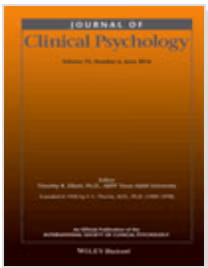 Objective: We tested a hypothesized model consistent with the notion that self-compassion mediates the association between negative life events and suicidal risk (viz., depressive symptoms & suicidal behaviors) in college students. Method: The sample was comprised of 331 college students. Self-compassion facets (viz., self-kindness, self-judgment, common humanity, isolation, mindfulness, & over-identification) were used in testing for multiple mediation, controlling for sex. Results: Common humanity, mindfulness, and over-identification were found to mediate the association between negative life events and depressive symptoms. However, common humanity was found to be the only mediator of the association between negative life events and suicidal behaviors. Conclusions: These findings suggest that there are specific facets of self-compassion that account for the association between negative life events and suicidal risk in college students and that (loss of) common humanity plays a central role in this process.
Objective: We tested a hypothesized model consistent with the notion that self-compassion mediates the association between negative life events and suicidal risk (viz., depressive symptoms & suicidal behaviors) in college students. Method: The sample was comprised of 331 college students. Self-compassion facets (viz., self-kindness, self-judgment, common humanity, isolation, mindfulness, & over-identification) were used in testing for multiple mediation, controlling for sex. Results: Common humanity, mindfulness, and over-identification were found to mediate the association between negative life events and depressive symptoms. However, common humanity was found to be the only mediator of the association between negative life events and suicidal behaviors. Conclusions: These findings suggest that there are specific facets of self-compassion that account for the association between negative life events and suicidal risk in college students and that (loss of) common humanity plays a central role in this process.
PERSONAL AND FAMILY GROWTH INITIATIVE AS PREDICTORS OF STUDY ENGAGEMENT IN CHINESE AND AMERICAN COLLEGE STUDENTS: IS THERE ANY EVIDENCE FOR GROUP DIFFERENCES?
Edward C. Chang & Hongfei Yang
Personality and Individual Differences.
 The present study examined the relationship between personal growth initiative (PGI), family growth initiative (FGI), and study engagement in a sample of 379 Chinese and 351 American college students. Consistent with expectations, PGI was found to predict different facets of study engagement in both cultural groups. When FGI was included, a consistent difference between Chinese and American students emerged. Specifically, FGI was found to account for additional amounts of variance in study engagement in Chinese students, but not in American students. Overall, our findings support the cross-cultural relevance of PGI in predicting studying engagement across college students from the East and West, and also point to the value of considering additional sources of growth for students that come from cultures that traditionally place a strong focus on the group.
The present study examined the relationship between personal growth initiative (PGI), family growth initiative (FGI), and study engagement in a sample of 379 Chinese and 351 American college students. Consistent with expectations, PGI was found to predict different facets of study engagement in both cultural groups. When FGI was included, a consistent difference between Chinese and American students emerged. Specifically, FGI was found to account for additional amounts of variance in study engagement in Chinese students, but not in American students. Overall, our findings support the cross-cultural relevance of PGI in predicting studying engagement across college students from the East and West, and also point to the value of considering additional sources of growth for students that come from cultures that traditionally place a strong focus on the group.
PERCEIVED INTERPERSONAL SOURCES OF LIFE SATISFACTION IN CHINESE AND AMERICAN STUDENTS: CULTURAL OR GENDER DIFFERENCES?
Edward C. Chang, Hongfei Yang, & Tina Yu
The Journal of Positive Psychology.
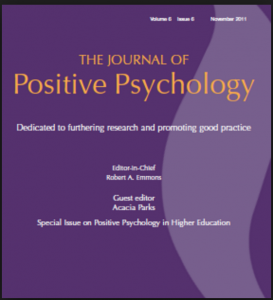 This study evaluated cultural and gender differences in perceived interpersonal sources of life satisfaction between 341 Chinese and 222 American college students. Comparative analyses indicated overall lower life satisfaction in Chinese, than in Americans. However, Chinese, compared to Americans, reported greater life satisfaction derived from perceived sources involving the self, parents, teachers, and peers. Results of regression analyses indicated that, for both Chinese and Americans, the self and parents were unique sources associated with life satisfaction. However, for Americans, close friends also emerged as an additional unique source. When gender differences were examined, additional nuances were found within each cultural group. Thus, some evidence for both cultural and gender differences in perceived interpersonal sources of life satisfaction across Chinese and Americans was found. Some implications of the present findings are discussed.
This study evaluated cultural and gender differences in perceived interpersonal sources of life satisfaction between 341 Chinese and 222 American college students. Comparative analyses indicated overall lower life satisfaction in Chinese, than in Americans. However, Chinese, compared to Americans, reported greater life satisfaction derived from perceived sources involving the self, parents, teachers, and peers. Results of regression analyses indicated that, for both Chinese and Americans, the self and parents were unique sources associated with life satisfaction. However, for Americans, close friends also emerged as an additional unique source. When gender differences were examined, additional nuances were found within each cultural group. Thus, some evidence for both cultural and gender differences in perceived interpersonal sources of life satisfaction across Chinese and Americans was found. Some implications of the present findings are discussed.
EXAMINING GENDER DIFFERENCES IN THE ROLES OF MEANING IN LIFE AND INTERPERSONAL EXPECTANCIES IN DEPRESSIVE SYMPTOMS
Elizabeth A. Yu, Edward C. Chang, Tina Yu, Sarah C. Bennett, & Erin E. Fowler
Gender Issues.
 In the present study, we examined for gender differences in meaning in life (viz., presence of & searching for) and interpersonal expectancies (viz., positive & negative) as additive and interactive predictors of depressive symptoms in a sample of 117 male and 132 female college students. We found that meaning in life accounted for a significant amount of variance in depressive symptoms for both men and women, and while presence of meaning in life was a significant predictor of depressive symptoms for both groups, it was a stronger predictor among women compared to men. Furthermore, we found that interpersonal expectancies accounted for additional variance in depressive symptoms above and beyond meaning in life for both groups, and interestingly, only positive interpersonal expectancy emerged as a significant predictor of depressive symptoms. Finally, the interactions involving meaning in life and interpersonal expectancies accounted for a significant amount of additional variance above and beyond the main effects for both men and women. However, a greater number of significant interactions emerged for women than for men. Implications of the present findings for understanding gender differences in meaning in life and interpersonal expectancies as predictors of depressive symptoms are discussed.
In the present study, we examined for gender differences in meaning in life (viz., presence of & searching for) and interpersonal expectancies (viz., positive & negative) as additive and interactive predictors of depressive symptoms in a sample of 117 male and 132 female college students. We found that meaning in life accounted for a significant amount of variance in depressive symptoms for both men and women, and while presence of meaning in life was a significant predictor of depressive symptoms for both groups, it was a stronger predictor among women compared to men. Furthermore, we found that interpersonal expectancies accounted for additional variance in depressive symptoms above and beyond meaning in life for both groups, and interestingly, only positive interpersonal expectancy emerged as a significant predictor of depressive symptoms. Finally, the interactions involving meaning in life and interpersonal expectancies accounted for a significant amount of additional variance above and beyond the main effects for both men and women. However, a greater number of significant interactions emerged for women than for men. Implications of the present findings for understanding gender differences in meaning in life and interpersonal expectancies as predictors of depressive symptoms are discussed.
NEUROTICISM AND SUICIDAL BEHAVIOR: CONDITIONAL INDIRECT PROBLEM-SOLVING AND HOPLESSNESS
Kristin L. Walker, Edward C. Chang, and Jameson K. Hirsch
International Journal of Mental Health and Addiction.
Purpose: Individuals with problem solving deficits, and higher levels of neuroticism and hopelessness, are at increased risk for suicide, yet little is known about the interrelationships between these vulnerability characteristics. Methods: In a sample of 223 low-income, primary care patients, we examined the potential mediating role of hopelessness on the relation between neuroticism and suicidal behavior, and the potential moderating role of social problem solving ability. Participants completed self-report questionnaires: Suicidal Behaviors Questionnaire-Revised, Social Problem Solving Inventory-Revised, Beck Hopelessness Scale, and NEO Five Factor Inventory. Models were tested using bootstrapped moderated mediation techniques. Results: There was a significant indirect effect of neuroticism on suicidal behavior through hopelessness, and this indirect effect was moderated by social problem solving ability. Conclusion: Patients with greater neuroticism also manifest greater levels of hopelessness and, in turn, more suicidal behavior, and these relations are strengthened at lower levels of social problem solving. Interventions that increase social problem solving ability and reduce hopelessness may reduce suicide risk.
ETHNIC VARIALES AND NEGATIVE LIFE EVENTS AS PREDICTORS OF DEPRESSIVE SYMPTOMS AND SUICIDAL BEHAVIORS IN LATINO COLLEGE STUDENTS: ON THE CENTRALITY OF RECEPTIVO A LOS DEMÁS
Edward C. Chang, Elizabeth A. Yu, Tina Yu, Emma R. Kahle, Viviana Hernandez, Jean M. Kim, Elizabeth L. Jeglic, & Jameson K. Hirsch
Hispanic Journal of Behavioral Sciences.
In the present study, we examined ethnic variables (viz., multigroup ethnic identity & other-group orientation; Phinney, 1992) along with negative life events as statistical correlates and predictors of depressive symptoms and suicidal behaviors in a sample of 156 (38 male & 118 female) Latino college students. Consistent with expectations, we found ethnic variables to be associated with lower depressive symptoms and suicidal behaviors. Additionally, we found negative life events to be associated with greater depressive symptoms and suicidal behaviors. Results of conducting hierarchical regression analyses indicated that the set of ethnic variables, accounted for significant variance in both depressive symptoms and suicidal behaviors. Other group orientation emerged as the most robust individual statistical predictor of the set. The inclusion of negative life events was found to account for significant additional variance in both outcomes, beyond what was accounted for by ethnic variables. Interestingly, beyond main effects, results indicated a significant Other Group Orientation × Negative Life Events interaction effect to account for additional variance in depressive symptoms and suicidal behaviors. Some implications of the present findings are discussed, including the potential value for Latinos to broaden their attitudes and interactions with other ethnic groups.
HOPE AND TAUMA: EXAMINING A DIATHESIS-STRESS MODEL IN PREDICTING DEPRESSIVE AND ANXIOUS SYMPTOMS IN COLLEGE STUDENTS
Edward C. Chang, Tina Yu, & Olivia D. Chang
Personality and Individual Differences.
The present study sought to examine a diathesis-stress model involving hope and trauma history as predictors of depressive and anxious symptoms in a sample of 575 college students. Results from regression analyses indicated that hope and trauma were important and unique predictors of both depressive and anxious symptoms in students. Moreover, we found support for a significant Hope × Trauma interaction in predicting both depressive and anxious symptoms. Some implications of the present findings are discussed.
POSITIVE PSYCHOLOY IN RACIAL AND ETHNIC GROUPS: THEORY, RESEARCH, AND PRACTICE
Edward C. Chang, Christina A. Downey, Jameson K. Hirsch, & Natalie J. Lin
American Psychological Association.
Positive psychology has become a vibrant, well-regarded field of study, and a powerful tool for clinicians. But, for many years, the research in areas relevant to positive psychology, such as happiness, subjective well-being, and emotional intelligence, has been based on findings from largely White samples and has rarely taken the concerns of the ethnic community into consideration.
Now, for the first time, leaders in the field have come together to provide a comprehensive reference that focuses specifically on how a culturally-informed approach to positive psychology can help capitalize on the strengths of racial minority groups and have a greater potential to positively impact their psychological well-being. Taking into account the rich and diverse cultural histories of ethnic groups, the information presented in this volume can help clinicians use positive psychology to inspire minorities to be effective agents in their environments and communities.
Acting as a bridge between positive psychology theory and research — largely based on an essentialist view of human behavior — and the realities of practice and assessment in diverse groups, Positive Psychology in Racial and Ethnic Groupsfocuses on four main ethnic groups: Asian Americans, Latin Americans, African Americans, and American Indians.
Broken into five major sections — an introduction to the field, theory and research, assessment, clinical interventions, and a discussion of what the future may hold — this is a unique volume in the field, and a call to action for researchers and clinicians everywhere.
DEVELOPMENT OF THE FREQUENCY OF SUICIDAL IDEATION INVENTORY: EVIDENCE FOR THE VALIDITIY AND RELIABILITY OF A BREIF MEASURE OF SUICIDAL IDEATION FREQUENCY IN A COLLEGE STUDENT POPULATION
Edward C. Chang & Olivia D. Chang
Cognitive Therapy and Research.
The present research focused on the development of a brief measure of suicidal ideation (SI) frequency, namely, the Frequency of Suicidal Ideation Inventory (FSII). Study 1 examined the latent structure of the FSII in a sample of 399 US college students. Results of principle axis factoring indicated a one-factor solution accounting for 86.96% of the variance. Study 2 provided support for the internal reliability of the FSII across four different international samples (viz., US, Turkish, Hungarian, & Chinese). Within the US sample, the FSII was found to possess good six-week test-retest reliability. Moreover, an examination of the associations between the FSII and important measures associated with suicidal risk (e.g., depressive symptoms) and resilience (e.g., flourishing) provided support for the construct validity of our new measure in an independent sample of 143 US college students. Overall, the present findings provide promising evidence for the validity and reliability of the FSII as a brief measure of SI frequency in adults.
ASIAN AMERIAN VALUES AS PREDICTORS OF MEANING IN LIFE IN ASIAN AND EUROPEAN AMERICAN COLLEGE STUDENTS: EVIDENCE FOR CULTURAL DIFFERENCES?
Elizabeth A. Yu, Edward C. Chang, & Jackie H. J. Kim
Asian American Journal of Psychology.
In the present study, we examined for ethnocultural differences in how a variety of Asian American values predict meaning in life in a sample of 107 Asian American and 131 European American college students. Results indicated that Asian American values as a whole predicted a significant amount of variance for meaning in life, only for Asian American college students. As individual predictors, emotional self-control inversely predicted meaning in life for both Asian American and European American college students, the value of humility positively predicted meaning in life for Asian Americans, and the value of respect for family positively predicted meaning in life for European Americans. Some implications of the present findings are discussed.
IS THE PGIS-II REDUNDANT WITH THE HOPE SCALE?: EVIDENCE FOR THE UTILITY OF THE PGIS-II IN PREDICTING PSYCHOLOGICAL ADJUSTMENT IN ADULTS
Hongfei Yang & Edward C. Chang
Personality and Individual Differences.
 Shorey et al. (2007) found that the Personal Growth Initiative Scale (PGIS; Robitschek, 1998) did not add to the prediction of psychological adjustment (e.g., optimism, psychological distress) when hope was controlled for. Recently, Robitschek et al. (2012) developed the Personal Growth Initiative Scale-II (PGIS-II) which is predicated on four distinct dimensions, namely readiness for change, planfulness, using resources, and intentional behaviors. To determine if the PGIS-II accounts for additional variance in psychological adjustment above hope, we conducted the present study to address this concern in a sample of 227 college students. Results from our analysis indicated that the PGIS-II explained for, beyond hope, an additional 3-5% of variance in life satisfaction, optimism, depression, and anxiety. Planfulness was found to be the only significant predictor of psychological adjustment in the PGIS-II set. The findings suggest that the personal growth initiative, especially planfulness, is a positive construct distinct from hope.
Shorey et al. (2007) found that the Personal Growth Initiative Scale (PGIS; Robitschek, 1998) did not add to the prediction of psychological adjustment (e.g., optimism, psychological distress) when hope was controlled for. Recently, Robitschek et al. (2012) developed the Personal Growth Initiative Scale-II (PGIS-II) which is predicated on four distinct dimensions, namely readiness for change, planfulness, using resources, and intentional behaviors. To determine if the PGIS-II accounts for additional variance in psychological adjustment above hope, we conducted the present study to address this concern in a sample of 227 college students. Results from our analysis indicated that the PGIS-II explained for, beyond hope, an additional 3-5% of variance in life satisfaction, optimism, depression, and anxiety. Planfulness was found to be the only significant predictor of psychological adjustment in the PGIS-II set. The findings suggest that the personal growth initiative, especially planfulness, is a positive construct distinct from hope.
DEPRESSIVE SYMPTOMS IN SOUTH ASIAN, EAST ASIAN, AND EUROPEAN AMERICANS: EVIDENCE FOR ETHNIC DIFFERENCES IN COPING WITH ACADEMIC AND INTERPERSONAL STRESS?
Marisa Perera & Edward C. Chang
Asian American Journal of Psychology.
The present study sought to understand the role of ethnicity in the relationship between each of three distinct coping strategies (problem focused, active emotional, and avoidant emotional) and depressive symptoms in a sample of 81 South Asian Americans, 123 East Asian Americans and 117 European Americans. Hierarchical regression analyses indicated that use of avoidant emotional coping strategies is a consistent predictor of depressive symptoms when coping with either an academic or interpersonal stressful event. Additional analyses indicated a significant interaction effect between ethnicity and avoidant emotional coping for South Asian Americans and European Americans, in accounting for depressive symptoms when the stressful event was interpersonal, but not academic, in nature. Overall, the present findings support some evidence of ethnic differences in the relations between coping strategies and depressive symptoms for Asian American subgroups and European Americans.
PREDICTING EATING DISTURBANCES IN TURKISH ADULT FEMALES: EXAMINING THE ROLE OF INITMATE PARTNER VIOLENCE AND PERFECTIONISM
Mine Muyan, Edward C. Chang, Zunaira Jilani, & Tina Yu
Eating Behaviors.
In the present study, we sought to examine the relationships between intimate partner violence (IPV), perfectionism, and eating disturbances, namely, excessive dieting and bulimia, in a sample of 149 Turkish female college students. Results of conducting hierarchical regression analyses indicated that IPV accounted for significant variance in both excessive dieting and bulimic symptoms. Moreover, the inclusion of perfectionism was found to predict additional unique variance in eating disturbances, beyond what was accounted for by IPV. Specifically, we found parental expectations to be a significant predictor of dieting, and personal standards, doubts about actions, and parental criticism to be significant predictors of bulimia. Some implications of the present findings for understanding eating disturbances in Turkish women are discussed.
PERFECTIONISM AS A PREDICTOR OF SUICIDAL RISK IN TURKISH COLLEGE STUDENTS: DOES LONELINESS CONTRIBUTE TO FURTHER RISK?
Mine Muyan & Edward C. Chang
Cognitive Therapy and Research.
In the present study, we examined perfectionism and loneliness as predictors of suicidal risk (viz., depressive symptoms & suicide ideation) in a sample of 288 (170 females & 118 males) Turkish college students. Results of conducting hierarchical regression analyses indicated that certain dimensions of perfectionism, namely, parental criticism and doubts about actions, accounted for significant variance in both depressive symptoms and suicide ideation. The inclusion of loneliness as a predictor was found to predict additional unique variance in both suicidal risk measures, beyond what was accounted for by perfectionism. Results of predicting suicide ideation, controlling for depressive symptoms, indicated that parental criticism was the only significant perfectionism dimension to emerge. However, loneliness continued to account for a significant amount of additional unique variance. Some implications of the present findings for understanding suicidal risk in Turkish students are discussed.
LONELINESS, POSITIVE LIFE EVENTS, AND PSYCHOLOGICAL MALADJUSTMENT: WHEN GOOD THINGS HAPPEN, EVEN LONELY PEOPLE FEEL BETTER!
Edward C. Chang, Mine Muyan, & Jameson K. Hirsch
Personality and Individual Differences.
The present study investigated loneliness and positive life events as predictors of psychological maladjustment (viz., depression, hopelessness, & suicidal behaviors) in a sample of 327 adults. Beyond the expected role of loneliness in psychological maladjustment, positive life events was found to further augment the prediction of depression, hopelessness, and suicidal behaviors. In addition, the presence of positive life events was found to buffer the positive association between loneliness and maladjustment. Specifically, the positive association between loneliness and psychological maladjustment was found to be weaker for those who experienced a high number of positive life events, as opposed to those who experienced a low number of positive life events. Some implications for helping adults perceive or appreciate the presence of positive events in their lives are discussed.
RELATION BETWEEN SEXUAL ASSAULT AND NEGATIVE AFFECTIVE CONDITIONS IN FEMALE COLLEGE STUDENTS: DOES LOSS OF HOPE ACCOUNT FOR THE ASSOCIATION?
Edward C. Chang, Zunaira Jilani, Tina Yu, Jiachen Lin, Mine Muyan, & Jameson K. Hirsch
Journal of Interpersonal Violence.
The present study examined dispositional hope as a potential mediator of the association between sexual assault and negative affective conditions, namely, depressive and anxious symptoms in a sample of 223 female college students. Results from conducting bootstrapped mediation analyses indicated that hope agency, but not hope pathways, mediated the link between sexual assault victimization and negative affective conditions in females. Importantly, the associations of sexual assault with both depressive and anxious symptoms remained highly significant independent of hope. Some implications of the present findings are discussed.
RELATIONS BETWEEN MULTIDIMENSIONAL SPIRITUALITY AND DEPRESSIVE SYMPTOMS IN COLLEGE STUDENTS: EXAMINING HOPE AGENCY AND PATHWAYS AS POTENTIAL MEDIATORS
Edward C. Chang, Zunaira Jilani, Erin Fowler, Tina Yu, ShaoWei Chia, Elizabeth Yu, Hannah McCabe, & Jameson K. Hirsch
Journal of Positive Psychology.

In this study, we examined goal-focused hope as a potential mediator between the association of multidimensional spirituality and depressive symptoms in a sample of 319 college students. Results of conducting a series of multiple mediation tests indicated that hope agency, but not hope pathways, fully and significantly accounted for the associations of ritualistic, theistic, and existential spirituality with depressive symptoms. Overall, our findings offer support for the contention that hope agency plays an important role in accounting for the association between spirituality and psychological adjustment in college students. Some implications of the present findings are discussed.
SEXUAL ASSAULT AND DEPRESSIVE SYMPTOMS IN COLLEGE STUDENTS: DO PSYCHOLOGICAL NEEDS ACCOUNT FOR THE RELATIONSHIP?
Edward C. Chang, Jiachen Lin, Erin Fowler, Elizabeth Yu, Tina Yu, Zunaira Jilani, Emma Kahle, & Jameson K. Hirsch
Social Work.
 In this study, authors examined basic psychological needs (namely, competence, autonomy, and relatedness) as potential mediators of the association between sexual assault and depressive symptoms in a sample of 342 college students. Results from conducting a multiple mediation test provided support for partial mediation involving the indirect effects of competence and autonomy. In contrast, no support for mediation was found involving relatedness. It is notable that sexual assault remained a significant predictor of depressive symptoms in students. Therefore, findings indicate how sexual assault may both directly and indirectly (through psychological needs) lead to greater depressive symptoms in students. Authors concluded the article with a discussion of the implications of their findings for expanding the study of basic psychological needs in college students and the need for greater efforts to prevent and treat sexual assault on campus.
In this study, authors examined basic psychological needs (namely, competence, autonomy, and relatedness) as potential mediators of the association between sexual assault and depressive symptoms in a sample of 342 college students. Results from conducting a multiple mediation test provided support for partial mediation involving the indirect effects of competence and autonomy. In contrast, no support for mediation was found involving relatedness. It is notable that sexual assault remained a significant predictor of depressive symptoms in students. Therefore, findings indicate how sexual assault may both directly and indirectly (through psychological needs) lead to greater depressive symptoms in students. Authors concluded the article with a discussion of the implications of their findings for expanding the study of basic psychological needs in college students and the need for greater efforts to prevent and treat sexual assault on campus.
LONELINESS AND NEGATIVE AFFECTIVE CONDITIONS IN ADULTS: IS THERE ANY ROOM FOR HOPE IN PREDICTING ANXIETY AND DEPRESSIVE SYMPTOMS?
Mine Muyan, Edward C. Chang, Zunaira Jilani, Tina Yu, Mine Muyan, & Jameson K. Hirsch
The Journal of Psychology: Interdisciplinary and Applied.
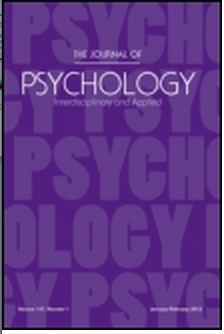 This study examined the role of hope in understanding the link between loneliness and negative affective conditions (viz., anxiety and depressive symptoms) in a sample of 318 adults. As expected, loneliness was found to be a significant predictor of both anxiety and depressive symptoms. Noteworthy, hope was found to significantly augment the prediction of depressive symptoms, even after accounting for loneliness. Furthermore, we found evidence for a significant Loneliness × Hope interaction effect in predicting anxiety. A plot of the interaction confirmed that the association between loneliness and anxiety was weaker among high, compared to low, hope adults. Some implications of the present findings are discussed.
This study examined the role of hope in understanding the link between loneliness and negative affective conditions (viz., anxiety and depressive symptoms) in a sample of 318 adults. As expected, loneliness was found to be a significant predictor of both anxiety and depressive symptoms. Noteworthy, hope was found to significantly augment the prediction of depressive symptoms, even after accounting for loneliness. Furthermore, we found evidence for a significant Loneliness × Hope interaction effect in predicting anxiety. A plot of the interaction confirmed that the association between loneliness and anxiety was weaker among high, compared to low, hope adults. Some implications of the present findings are discussed.
THE PURSUIT OF PERFECTION IN SPIRITUAL ENGAGEMENTS: THE CENTRALITY OF PARENTAL EXPECTATIONS AS A POSITIVE AND UNIQUE PREDICTOR
Edward C. Chang, Tina Yu, Zunaira Jilani, Mine Muyan, Jiachen Lin, & Jameson K. Hirsch
Personality and Individual Differences.

In the present study, we examined the relations between perfectionism and spirituality in a sample of college students. Results of correlational analyses were generally consistent with the notion that adaptive perfectionism dimensions (e.g., personal standards & organization) were positively associated with spirituality, whereas maladaptive perfectionism dimensions (e.g., concern over mistakes, parental criticism) were negatively associated with spirituality. Furthermore, results of conducting regression analyses provided support for perfectionism dimensions as unique predictors of different dimensions of spirituality. Interestingly, we found parental expectations to be a positive and unique predictor for all three dimensions of spirituality. Some implications on the importance of the present findings for future research on perfectionism and spirituality in adults are discussed.
FUNDAMENTAL DIMENSIONS OF PERSONALITY UNDERLYING SPIRITUALITY: FURTHER EVIDENCE FOR THE CONSTRUCT VALIDITY OF THE RiTE MEASURE OF SPIRITUALITY
Edward C. Chang, Zunaira Jilani, Tina Yu, Erin E. Fowler, Jiachen Lin, Jon R. Webb, & Jameson K. Hirsch
Personality and Individual Differences.

This study examined the construct validity of the RiTE as a multidimensional measure of spirituality in relation to the five-factor model of personality in a sample of 325 college students. Results of correlational and regression analyses provided support for the notion that the dimensions of ritualistic, theistic, and existential spirituality tapped by the RiTE are empirically distinguishable. Overall, our findings provide further evidence for the construct validity of the RiTE and for the potential value of measuring spirituality as a multidimensional phenomenon in the study of religious processes.
SOCIAL PROBLEM-SOLVING UNDER ASSAULT: UNDERSTANDING THE IMPACT OF SEXUAL ASSAULT ON THE RELATION BETWEEN SOCIAL PROBLEM-SOLVING AND SUICIDAL RISK IN FEMALE COLLEGE STUDENTS
Edward C. Chang & Jameson K. Hirsch
Cognitive Therapy and Research.
The present study sought to examine how social problem solving and sexual assault are involved in suicidal risk in a sample of 221 female college students. Specifically, we were interested to examine whether sexual assault may play an additive as well as interactive role in the prediction of suicidal risk (viz., hopelessness & suicidal behaviors) above and beyond social problem solving. Results from regression analyses indicated that deficits in social problem solving, especially low positive problem orientation, and sexual assault were important and unique predictors of suicidal risk in female students. Moreover, we found support for a Social Problem Solving × Sexual Assault interaction in predicting hopelessness. Significant interactions emerged specifically for negative problem orientation and impulsivity/carelessness style. Some important implications of the present findings are discussed.
HOPE UNDER ASSAULT: UNDERSTANDING THE IMPACT OF SEXUAL ASSAULT ON THE RELATION BETWEEN HOPE AND SUICIDAL RISK IN COLLEGE STUDENTS
Edward C. Chang, Tina Yu, Zunaira Jilani, Erin E. Fowler, Elizabeth A. Yu, Jiachen Lin, & Jameson K. Hirsch
Journal of Social and Clinical Psychology.

The present study sought to examine for how hope and sexual assault are involved in suicidal risk in a sample of 325 college students. Specifically, we were interested to examine whether sexual assault may play an additive as well as interactive role in the prediction of suicidal risk (viz., suicidal behaviors & reasons for living) above and beyond hope. Results from regression analyses indicated that hope and sexual assault were important and unique predictors of suicidal risk in students. Moreover, we found some support for a Hope × Sexual Assault interaction in predicting both suicidal behaviors and reasons for living. However, only the findings for suicidal behaviors remained after controlling for concurrent depressive symptomatology. Some important implications of the present findings are discussed.
LONELINESS UNDER ASSAULT: UNDERSTANDING THE IMPACT OF SEXUAL ASSAULT ON THE RELATION BETWEEEN LONELINESS AND SUICIDAL RISK IN COLLEGE STUDENTS
Edward C. Chang, Xiang Lian, Tina Yu, Junjie Qu, Bohan Zhang, Wenwen Jia, Qin Hu, Junzi Li, Jiaqing Wu, & Jameson K. Hirsch
Personality and Individual Differences.

The present study sought to examine for how loneliness and sexual assault are involved in predicting suicidal risk (viz., hopelessness & suicide probability) in a sample of 334 college students. Specifically, we were interested in examining whether sexual assault may play an additive as well as interactive role in the prediction of suicidal risk above and beyond loneliness. Results from regression analyses indicated that both loneliness and sexual assault were important and unique predictors of suicidal risk in students. Moreover, consistent with expectations, we found support for a Loneliness × Sexual Assault interaction in predicting both hopelessness and suicide probability. Inspection of the interactions indicated that the highest levels of suicidal risk were present for lonely students who had experienced some form of sexual assault. Some important implications of the present findings are discussed.
ETHNIC VARIATIONS BETWEEN ASIAN AND EUROPEAN AMERICANS IN INTERPERSONAL SOURCES OF SOCIALLY PRESCRIBED PERFECTIONSIM: IT’S NOT JUST ABOUT PARENTS!
Marisa J. Perera & Edward C. Chang
Asian American Journal of Psychology.

A set of interpersonal sources that represent the high standards of socially prescribed perfectionism (viz., parents, teachers, friends, peers, culture, intimate partner, & siblings) was tested as a predictor of socially prescribed perfectionism in a sample of European American and Asian American university students. Results indicated that there are several sources involved in socially prescribed perfectionism in both European Americans and Asian Americans. Noteworthy, beyond variance accounted for by parent standards, teacher standards were found to account for a large amount of variance in socially prescribed perfectionism in European Americans while peer standards were found to account for a large amount of variance in Asian Americans. Implications for future research involving ethnic variations in the interpersonal sources that represent the unrealistically high standards of socially prescribed perfectionism are discussed.
UNDERSTANDING THE RELATIONSHIP BETWEEN DOMESTIC ABUSE AND SUICIDE BEHAVIOR IN PRIMARY CARE ADULTS: DOES FORGIVENESS MATTER?
Edward C. Chang, Emma R. Kahle, Elizabeth A. Yu, & Jameson K. Hirsch
Social Work.

This study examined the relations between domestic abuse, forgiveness (of self vs. of others), and suicide behavior in a community sample of 101 primary care patients. As expected, greater experience of domestic abuse was associated with greater suicide behavior. Results from conducting mediation analyses, using bootstrapping techniques, provided support for a model in which the relationship between domestic abuse and suicide behavior was accounted for by forgiveness of self, but not by forgiveness of others. Some implications of the present findings for practice are discussed.
UNDERSTANDING HOW DOMESTIC ABUSE IS ASSOCIATED WITH GREATER DEPRESSIVE SYMPTOMS IN A COMMUNITY SAMPLE OF FEMALE PRIMARY CARE PATIENTS: DOES LACK OF BELONGINGNESS MATTER?
Edward C. Chang, Emma R. Kahle, & Jameson K. Hirsch
Violence Against Women.

This study examined the relationship between domestic abuse, belongingness, and depressive symptoms in a community sample of 71 female primary care patients. As expected, domestic abuse was associated with greater depressive symptoms. Results from conducting mediation analyses, including bootstrapping techniques, provided strong convergent support for a model in which the hypothesized effect of domestic abuse on depressive symptoms in women is mediated by a loss of belongingness. Noteworthy, even after controlling for content overlap between measures of belongingness and depressive symptoms, the mediation model remained significant. Some implications of the present findings are discussed.
EXAMINING THE STRUCTURE, RELIABILITY, AND VALIDITY OF THE CHINESE PERSONAL GROWTH INITIATIVE SCALE-II: EVIDENCE FOR THE IMPORTANCE OF INTENTIONAL SELF-CHANGE AMONG CHINESE
Hongfei Yang & Edward C. Chang
Journal of Personality Assessment.
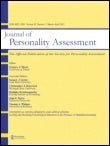
We examined the factor structure, reliability, and validity of the Chinese version of the Personal Growth Initiative Scale–II (CPGIS–II) using data from a sample of 927 Chinese university students. Consistent with previous findings, confirmatory factor analyses supported a 4-factor model of the CPGIS–II. Reliability analyses indicated that the 4 CPGIS–II subscales, namely Readiness for Change, Planfulness, Using Resources, and Intentional Behavior, demonstrated good internal consistency reliability and adequate test–retest reliability across a 4-week period. In addition, evidence for convergent and incremental validity was found in relation to measures of positive and negative psychological adjustment. Finally, results of hierarchical regression analyses indicated that the 4 personal growth initiative dimensions, especially planfulness, accounted for additional unique variance in psychological adjustment beyond resilience. Some implications for using the CPGIS–II in Chinese are discussed.
